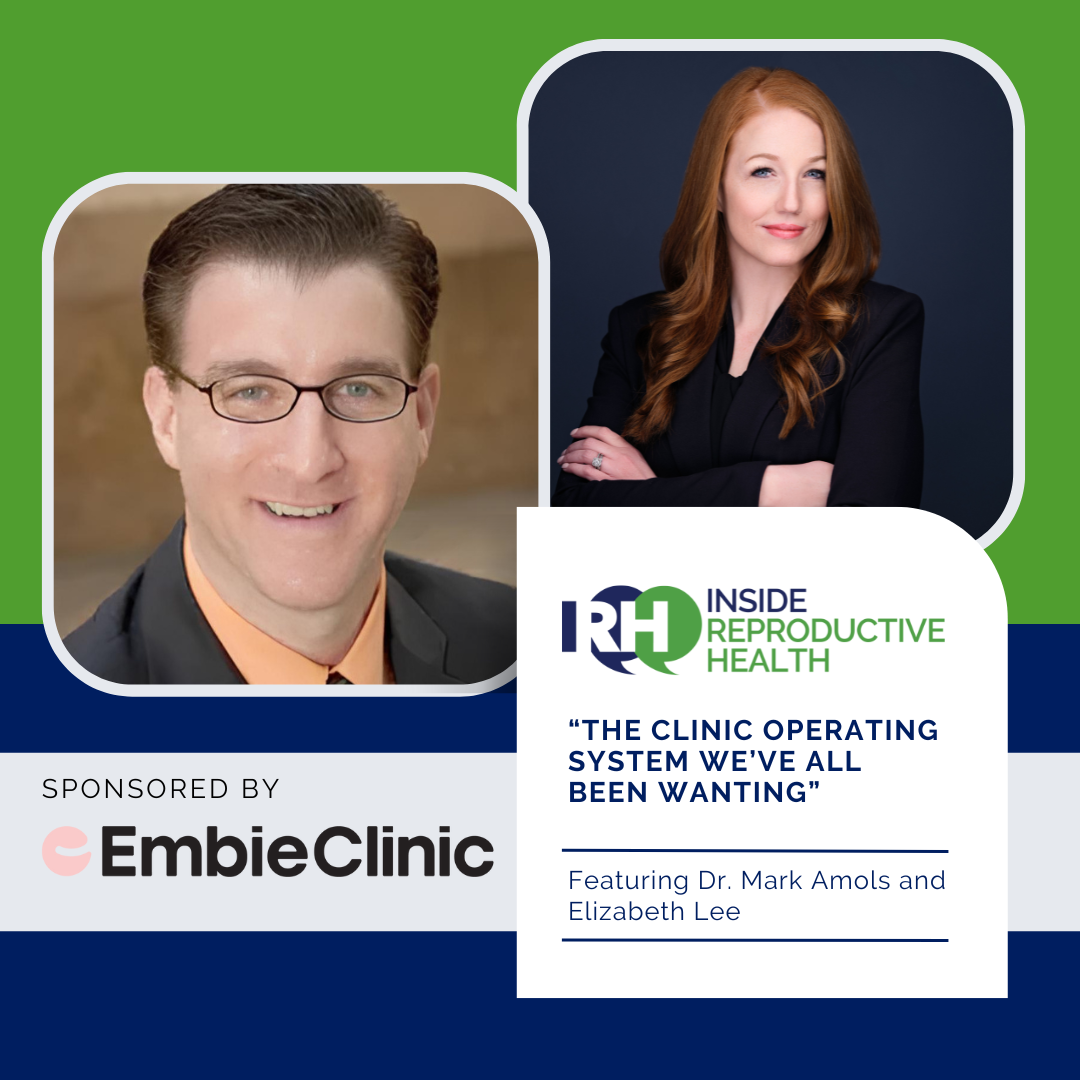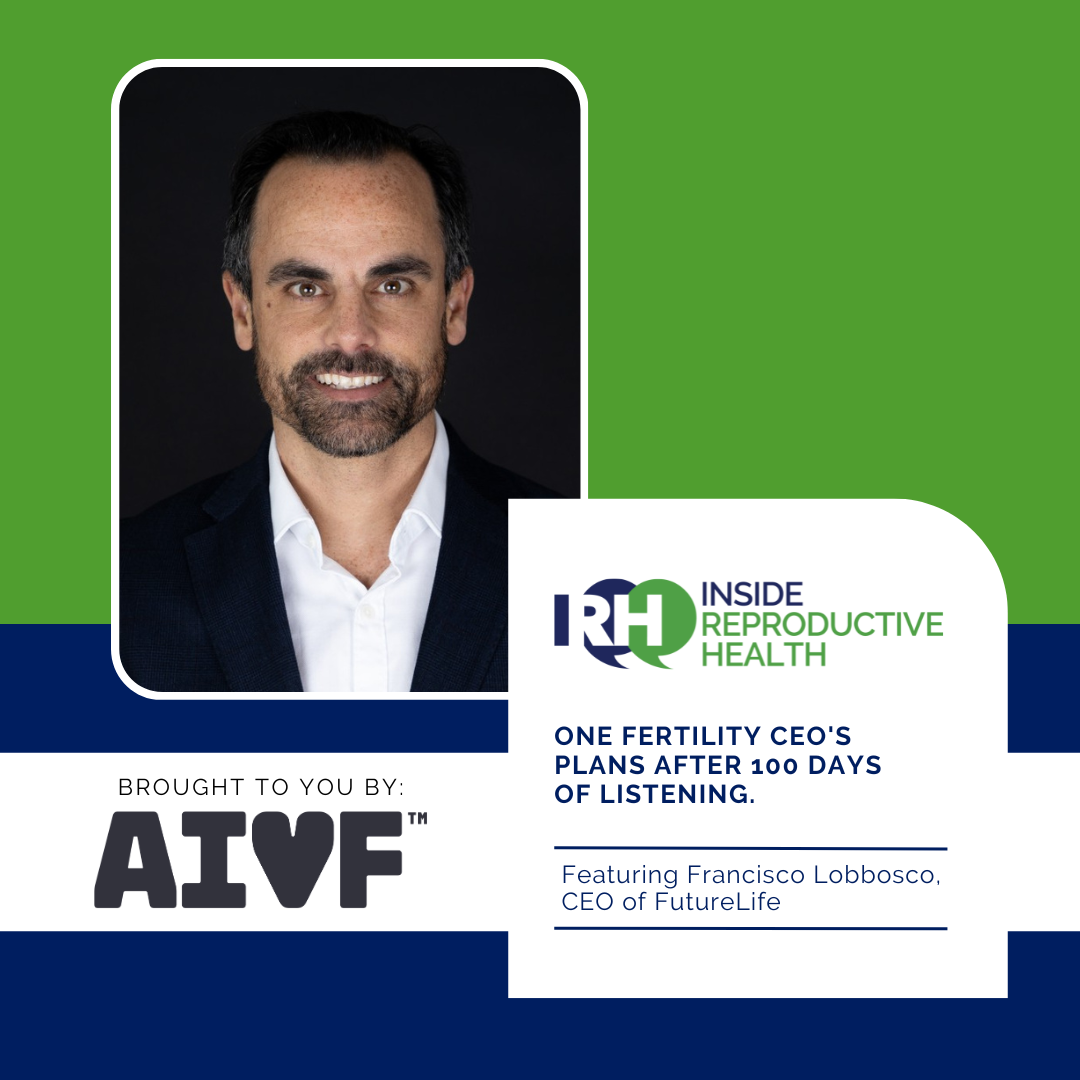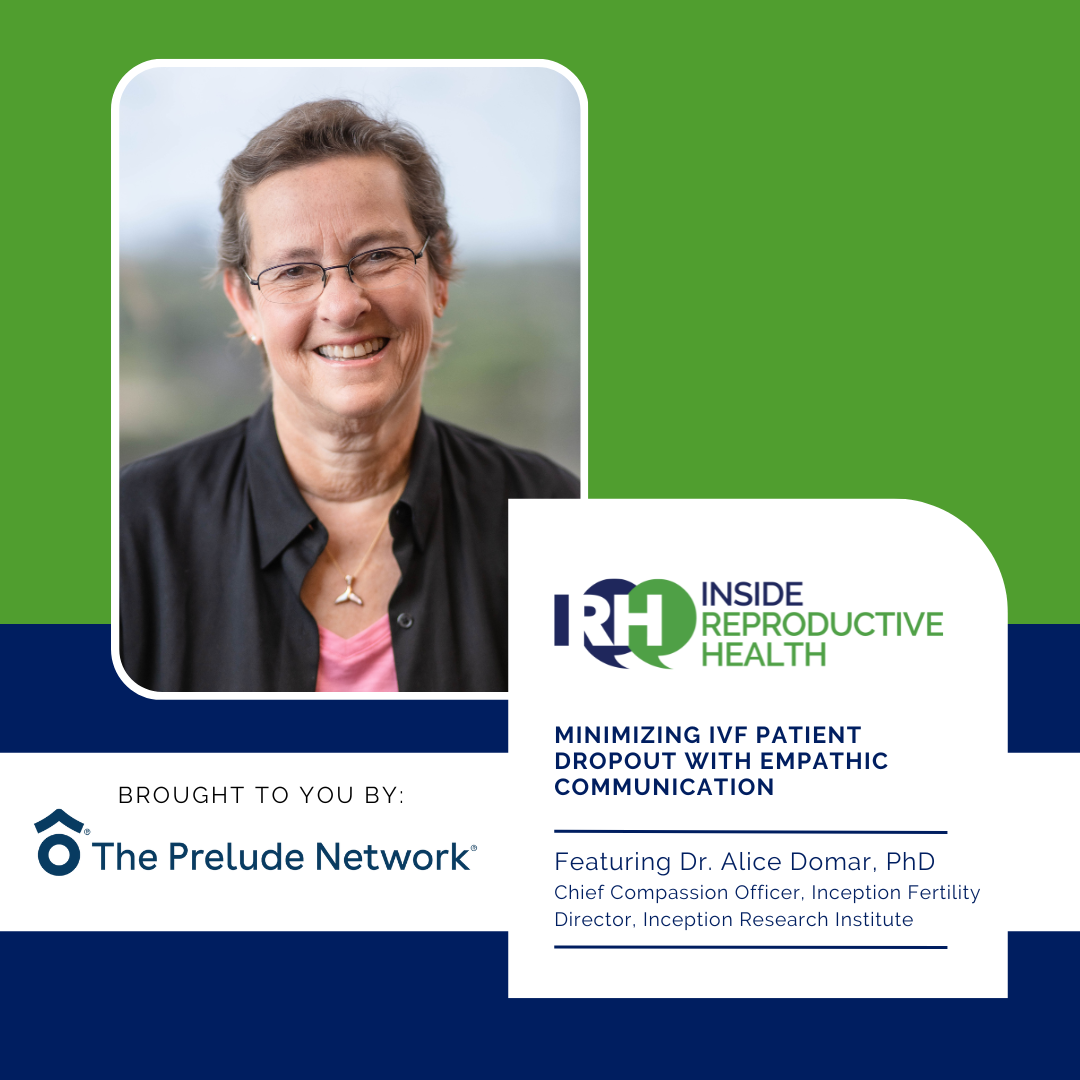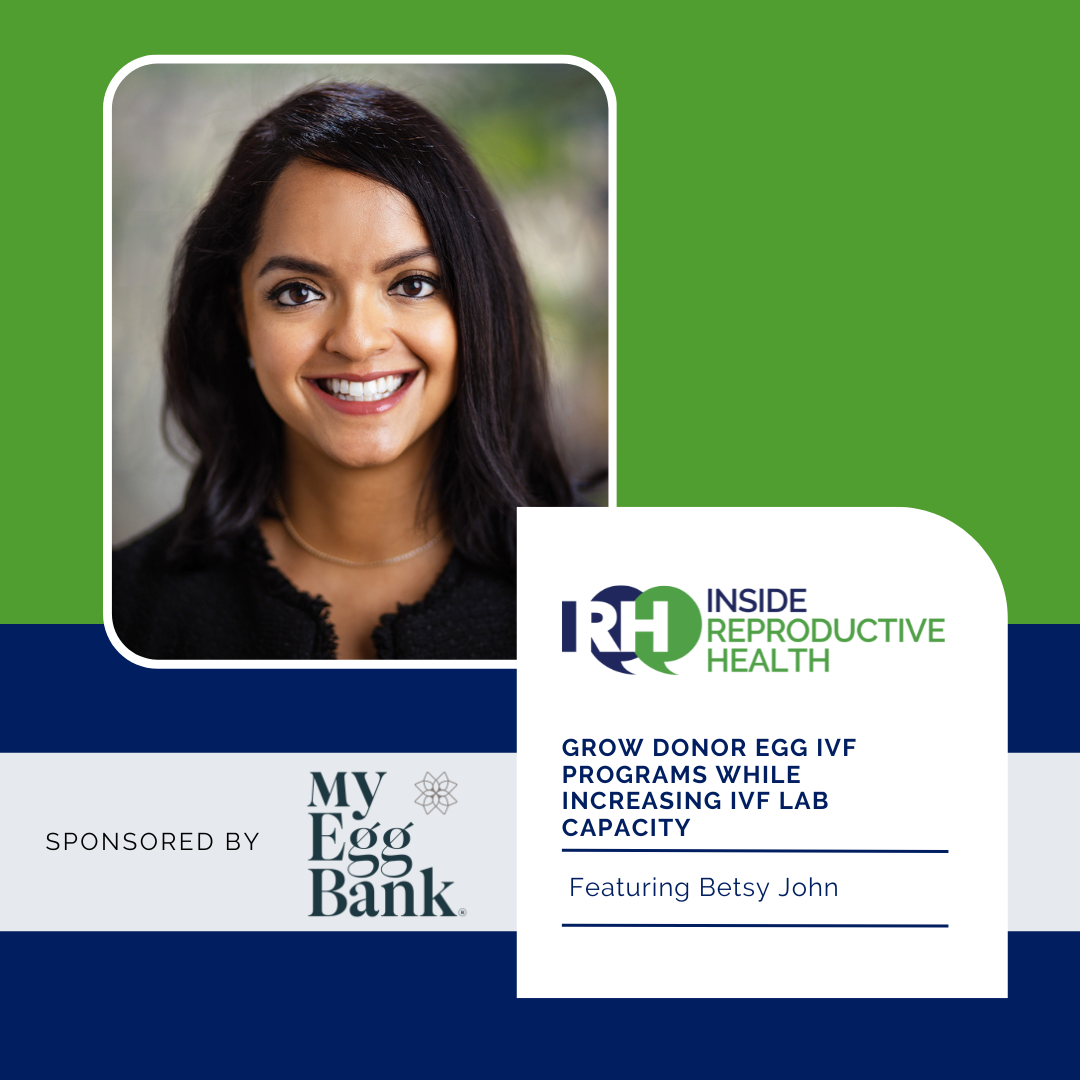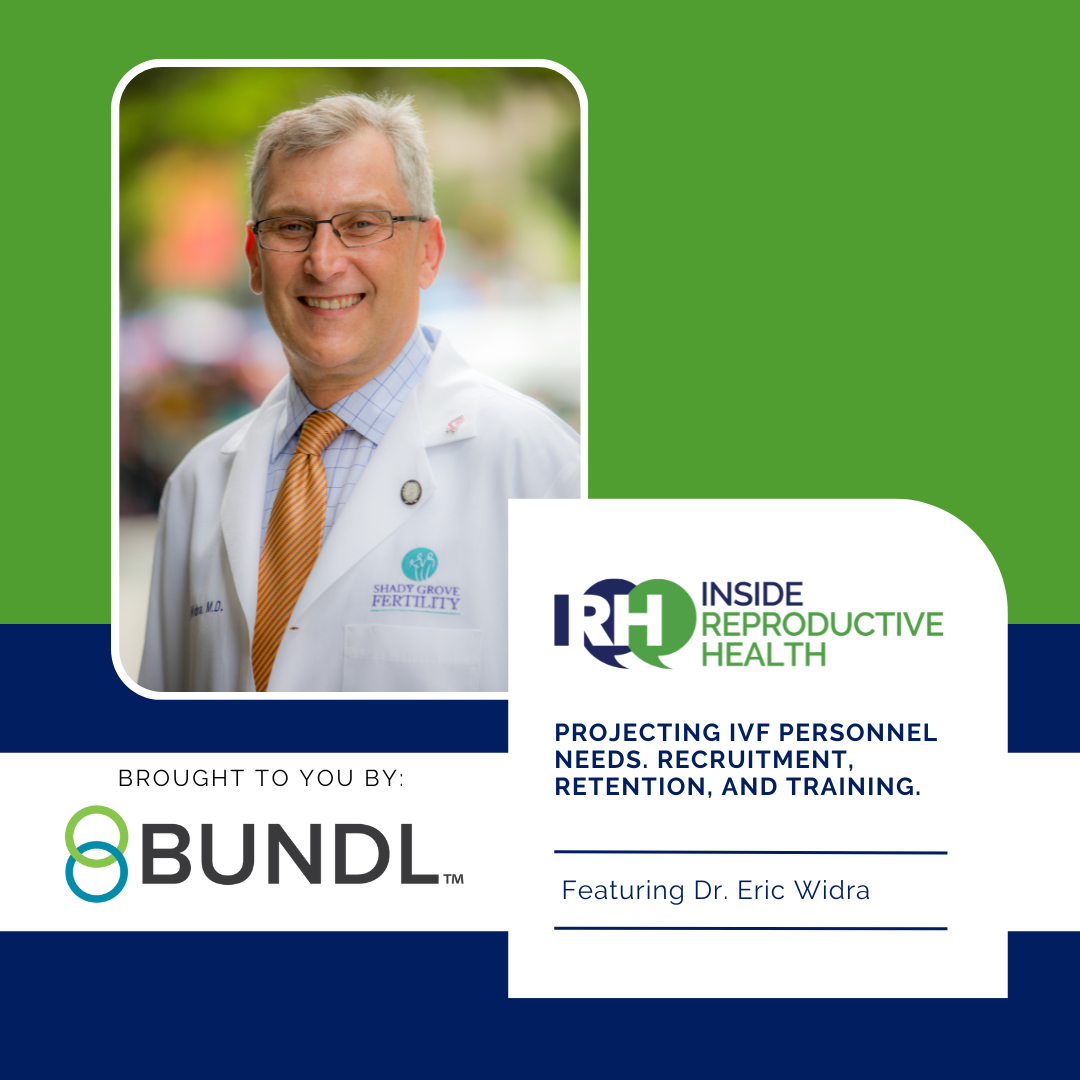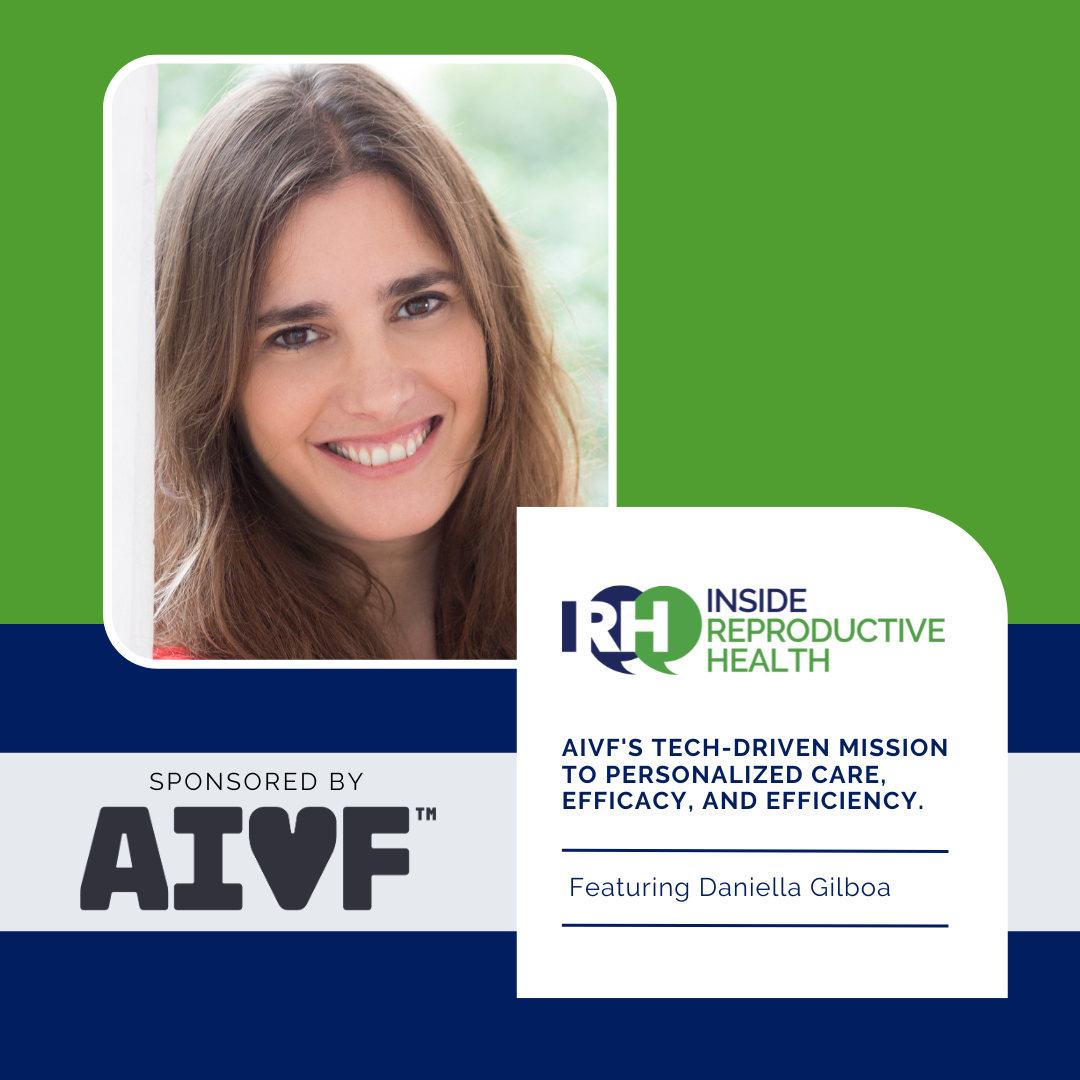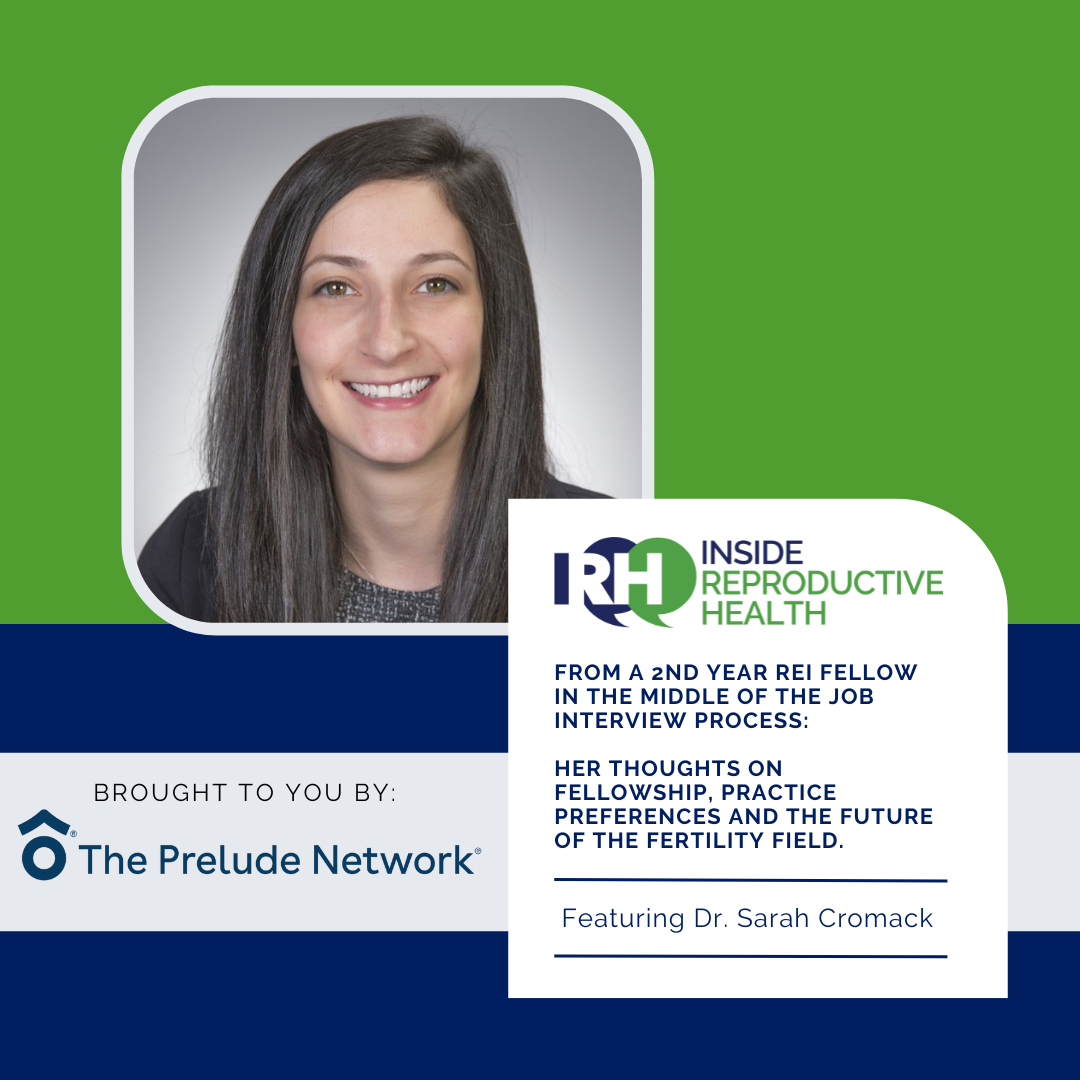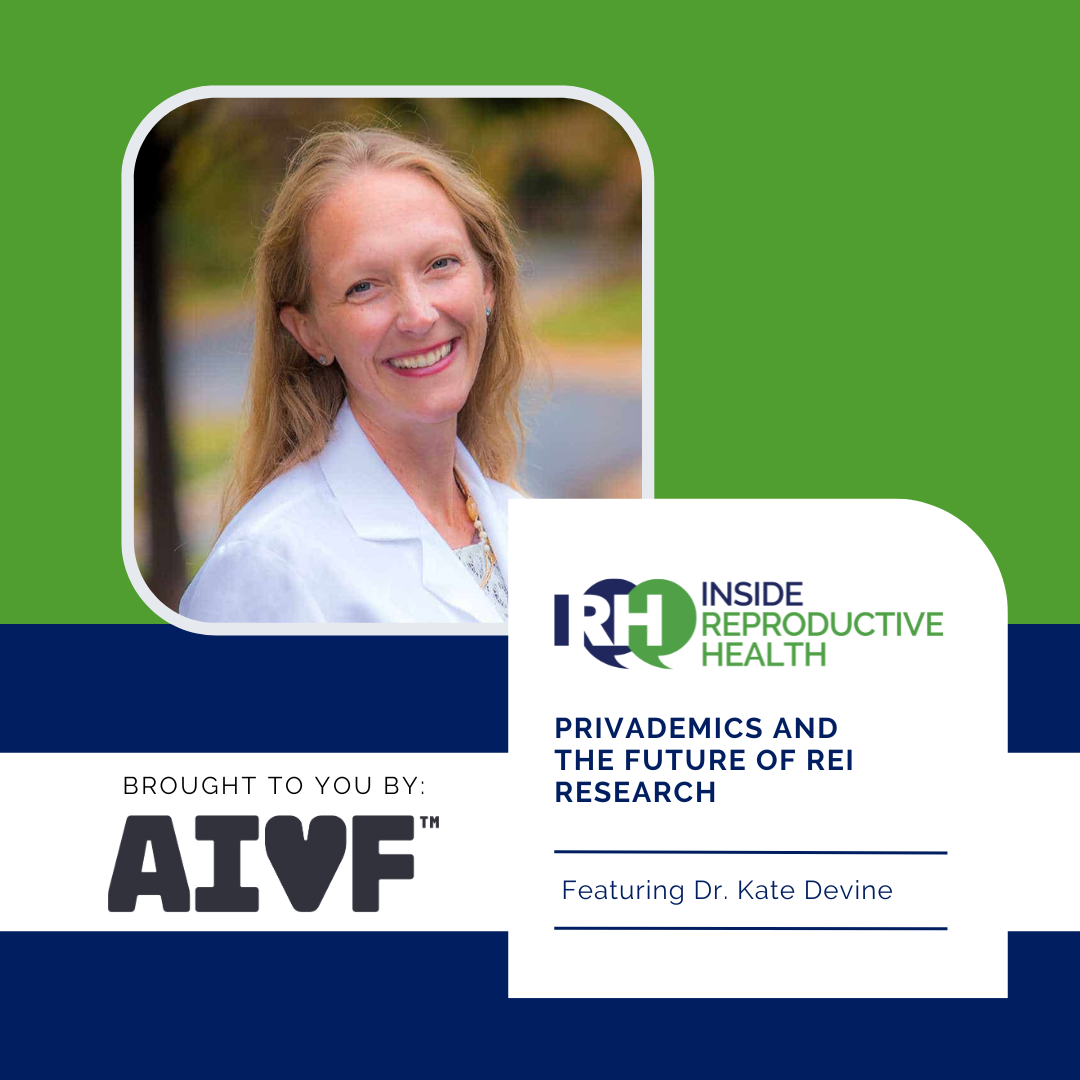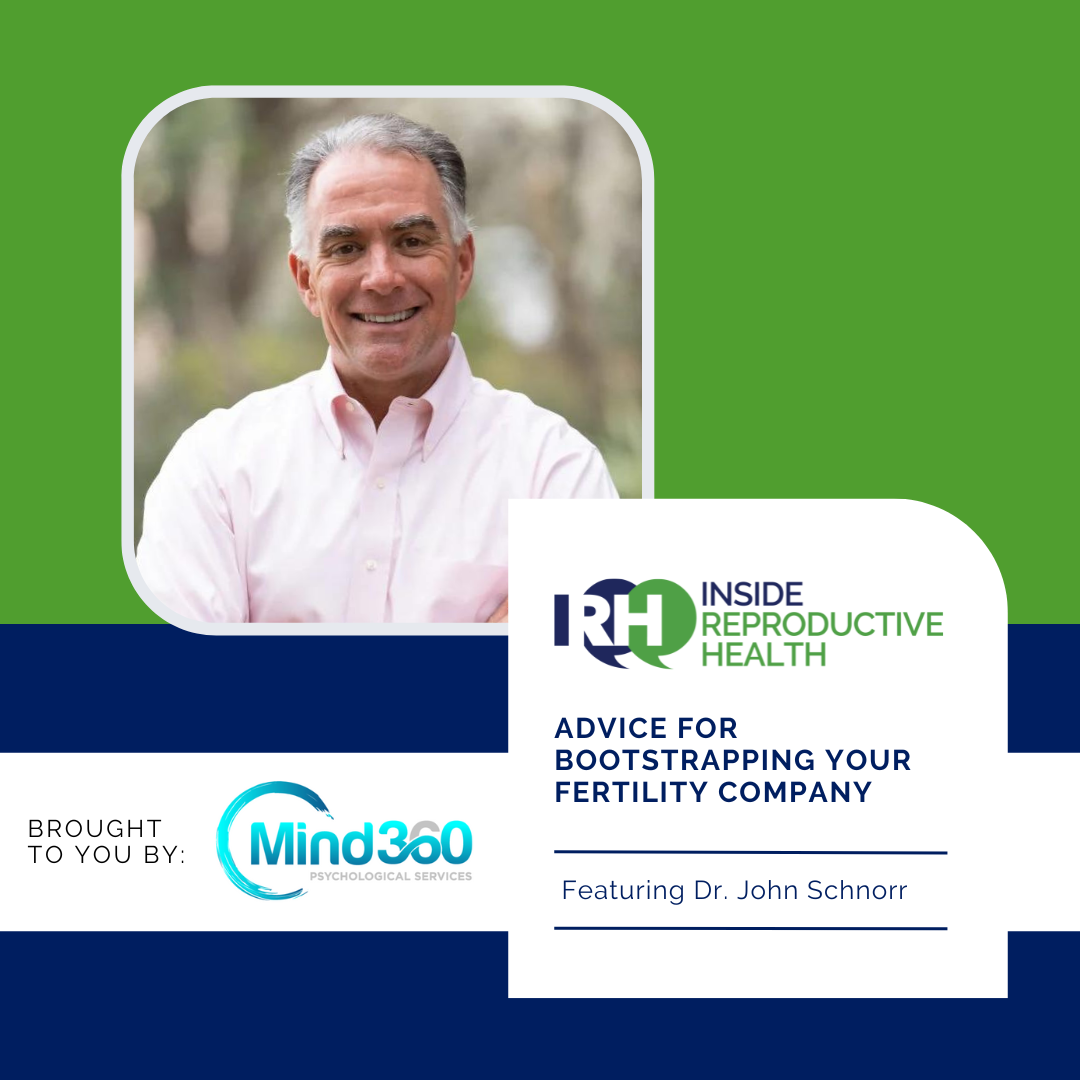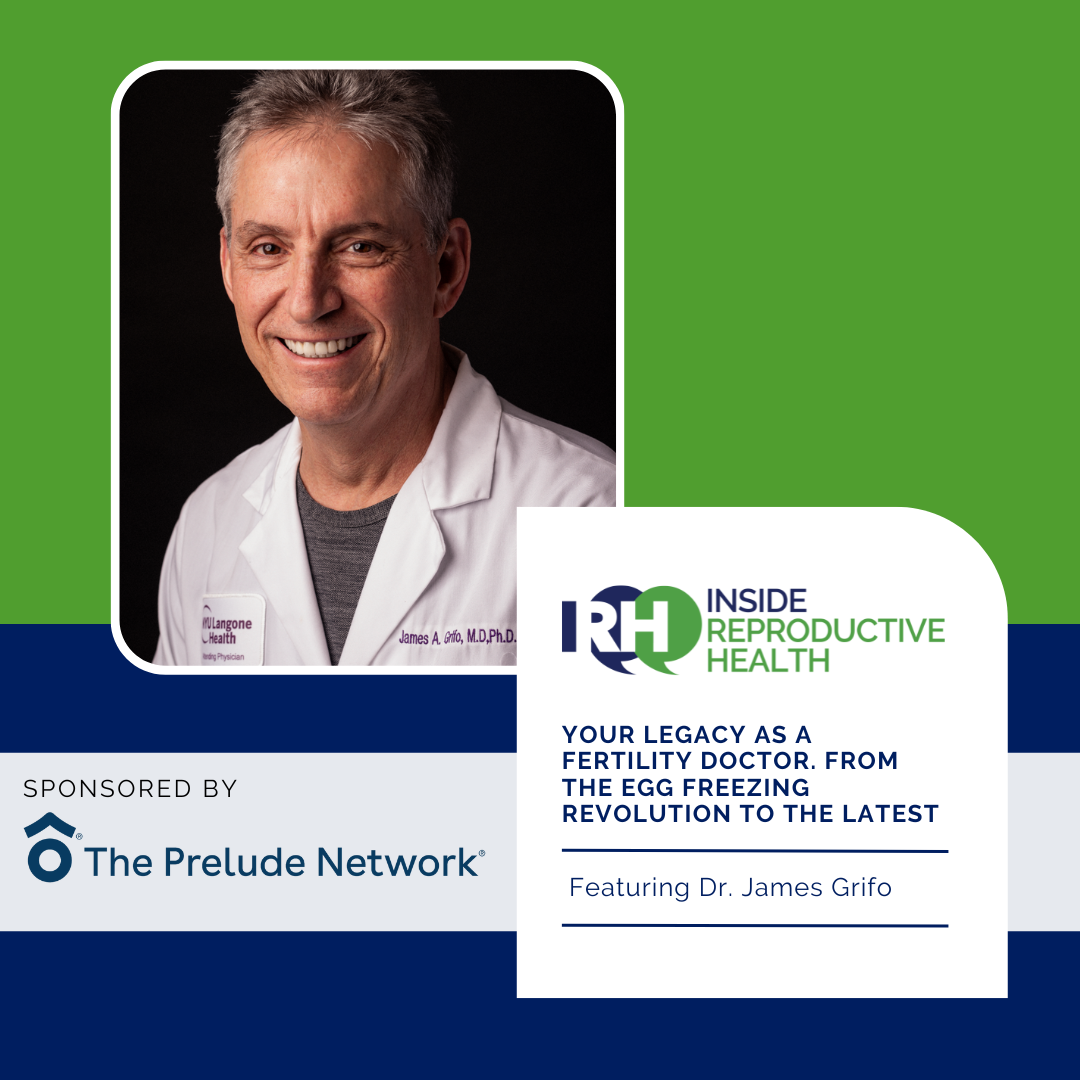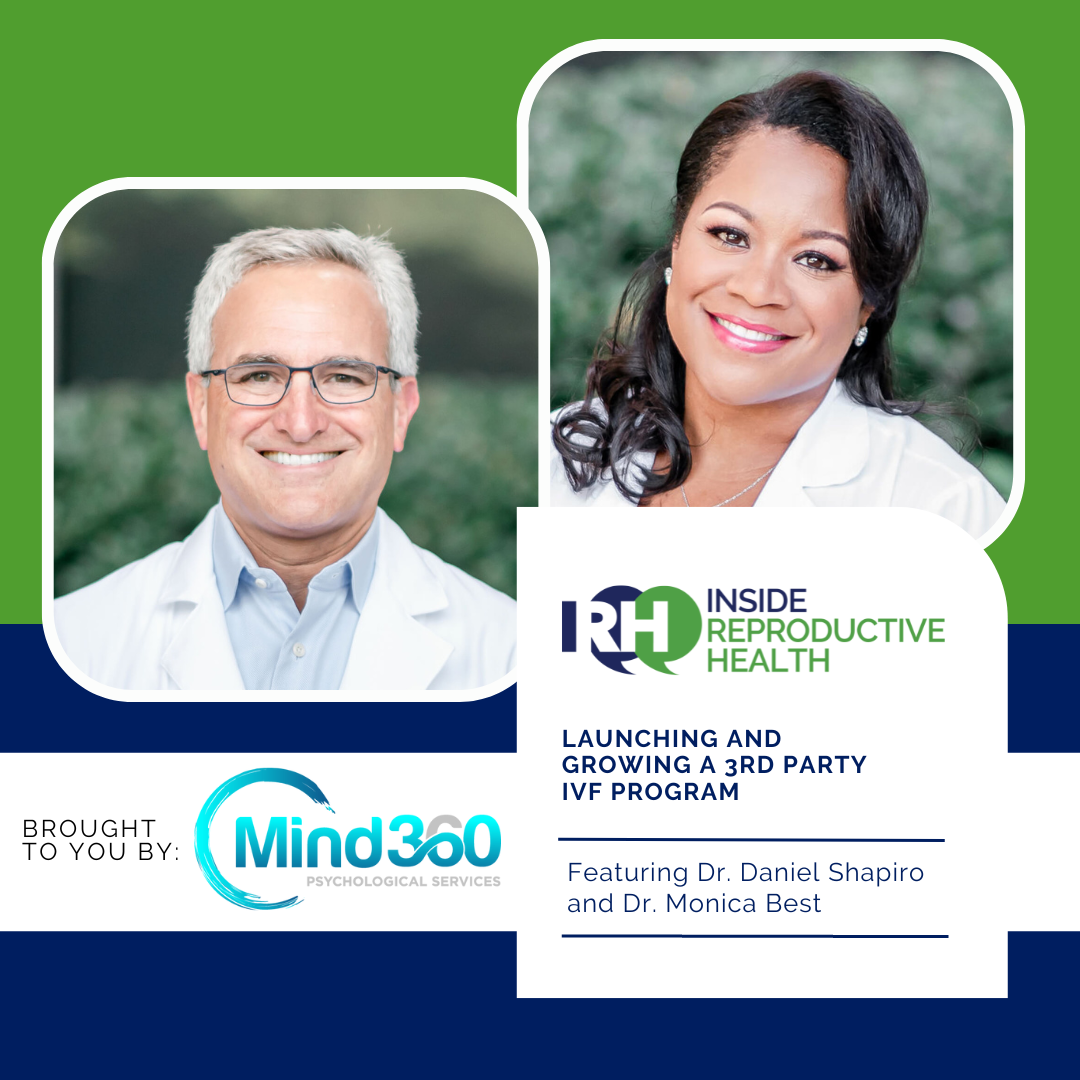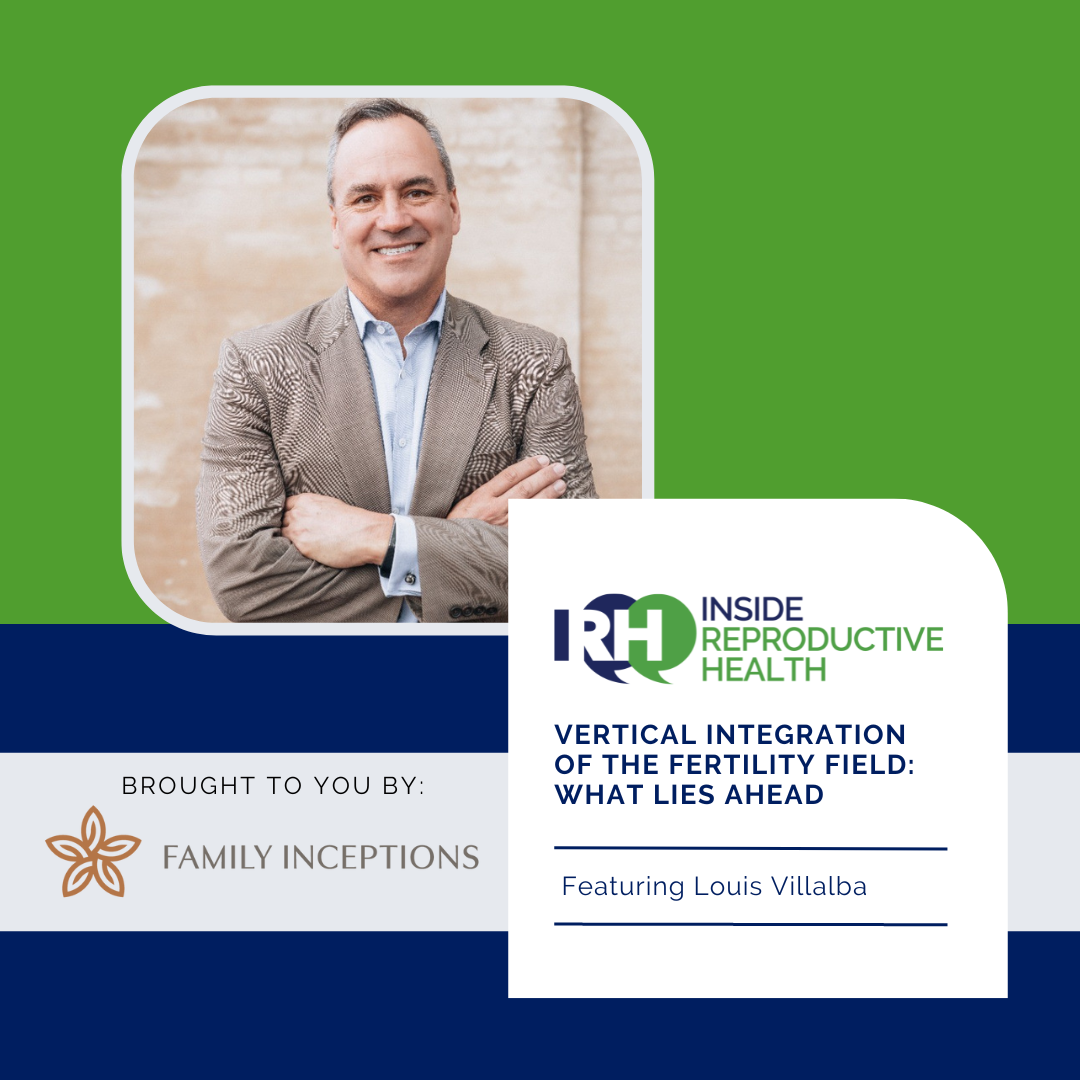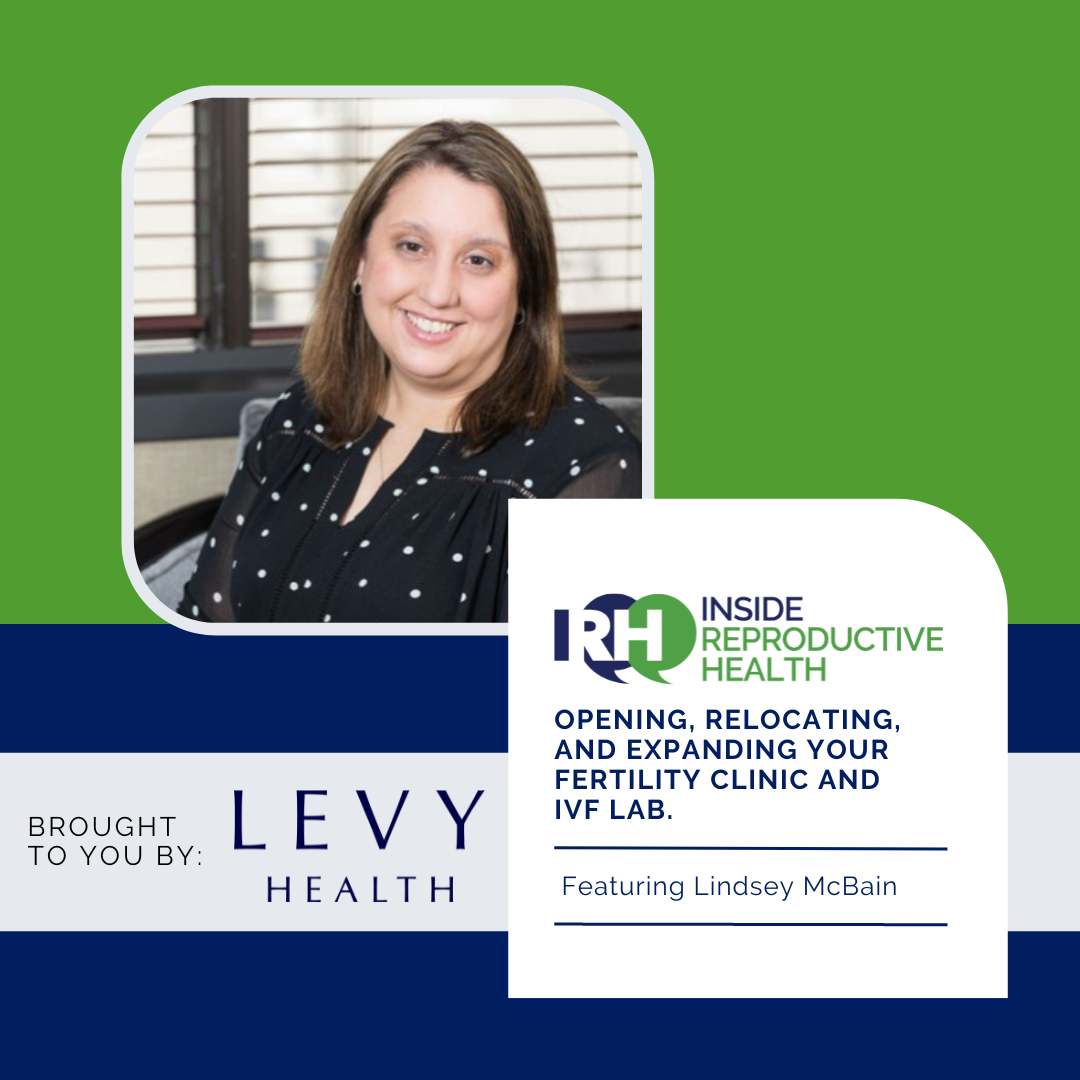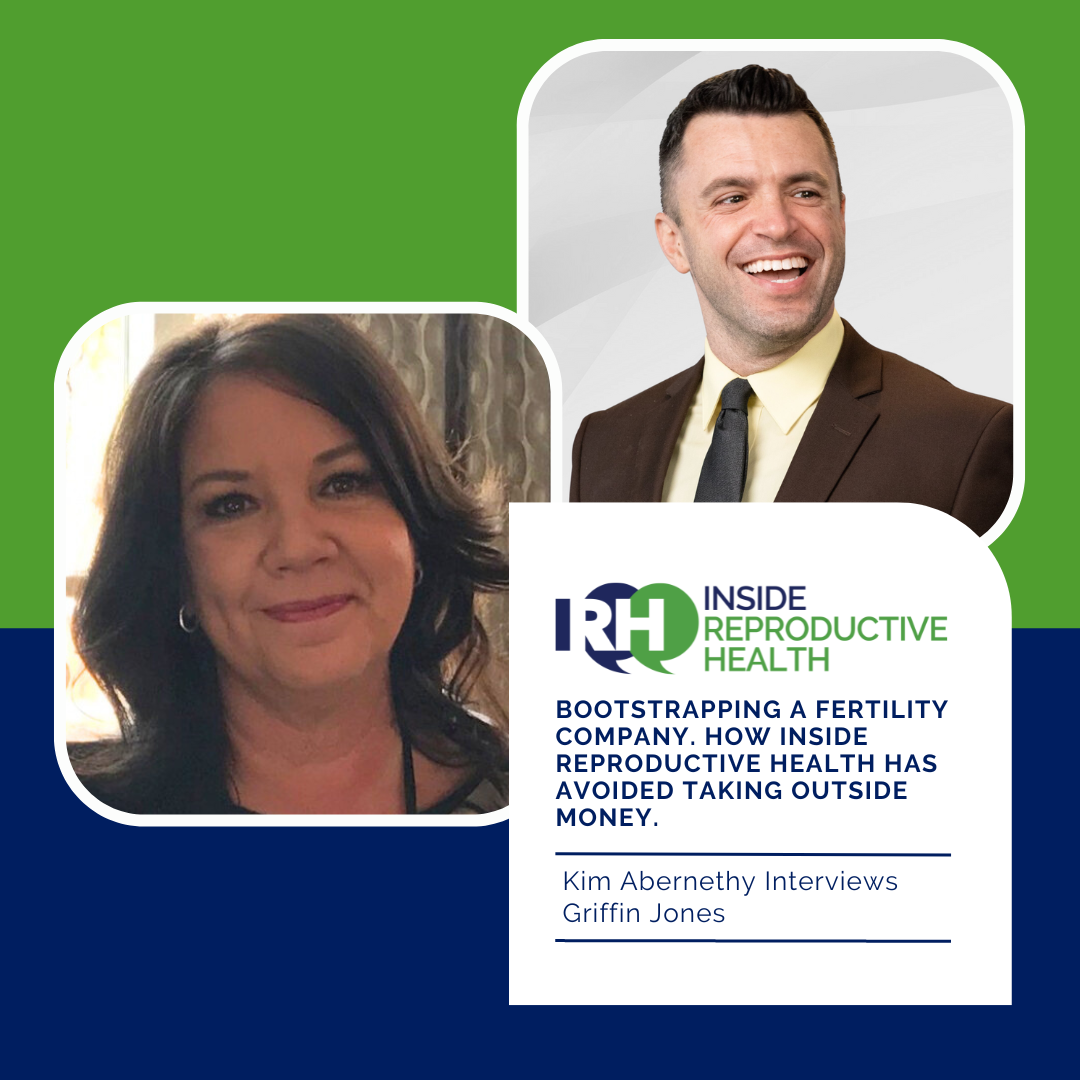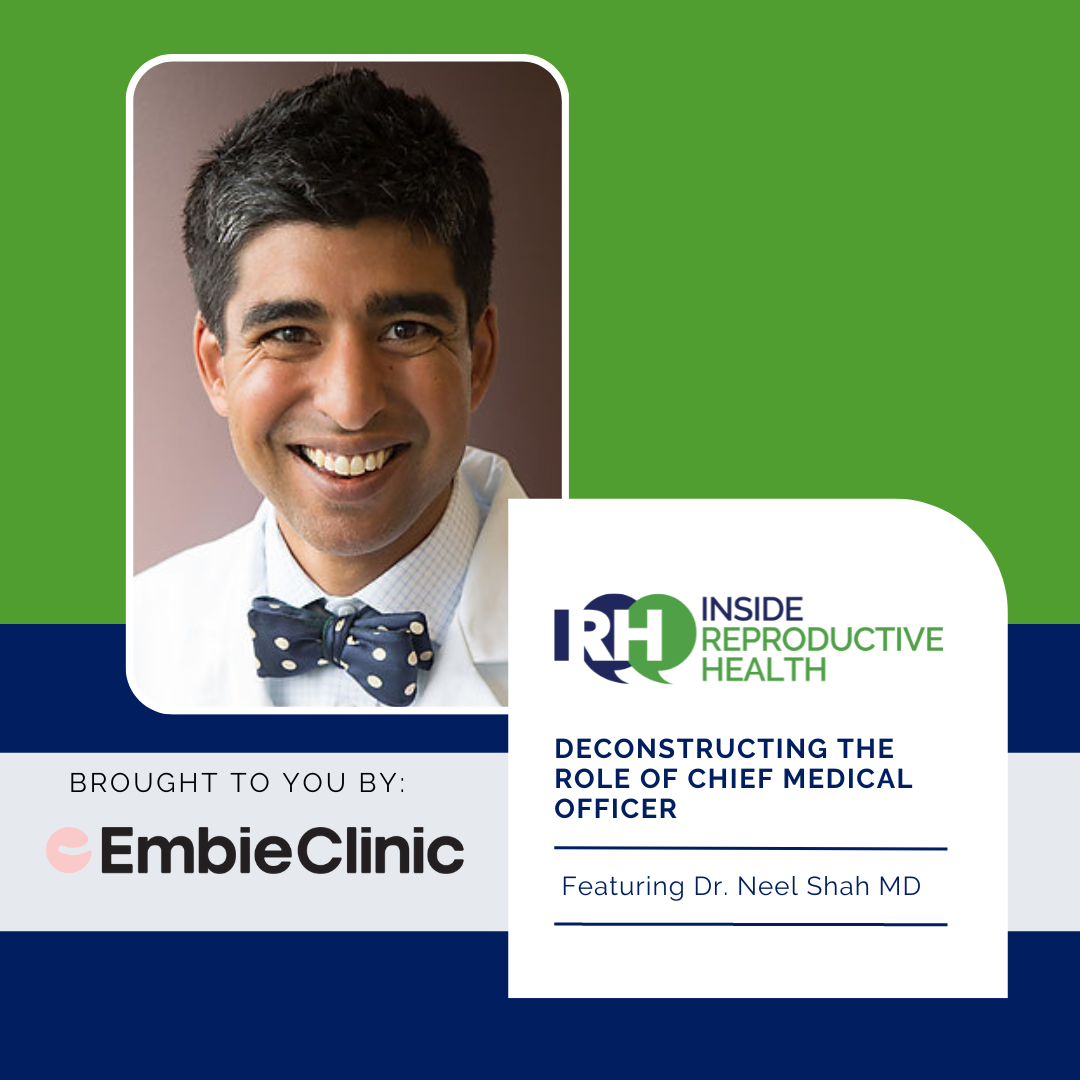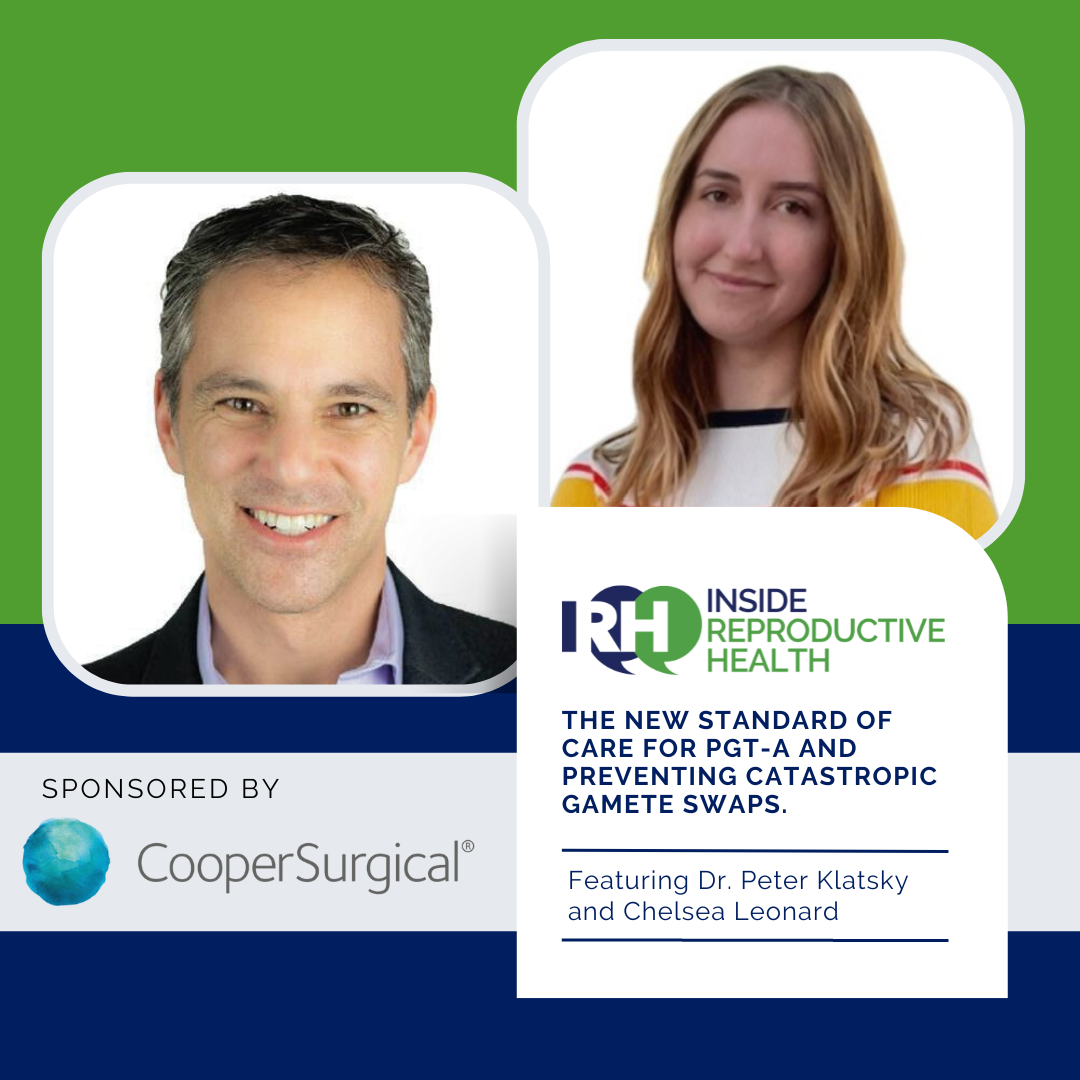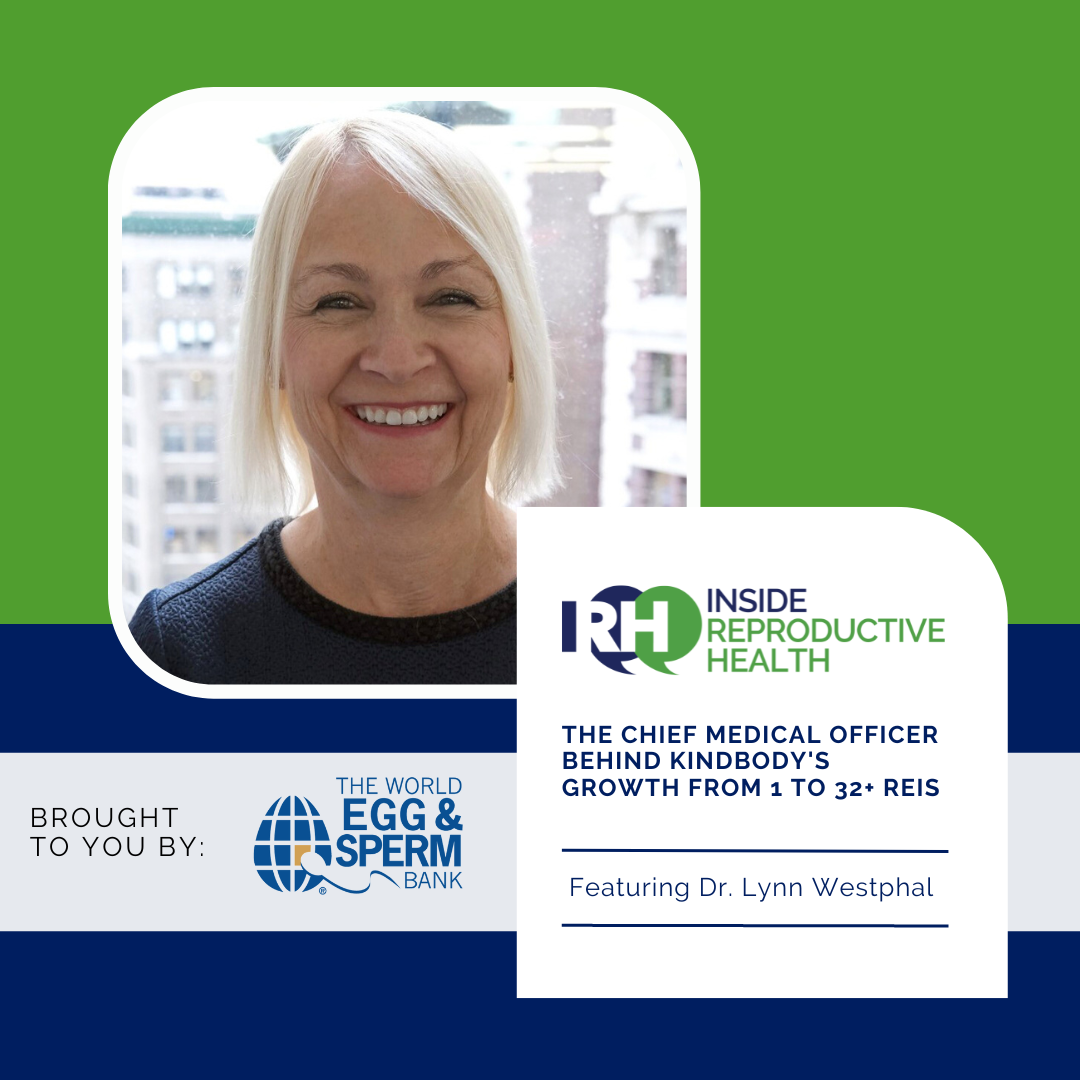DISCLAIMER: Today’s episode is paid content from our feature sponsor, who helps Inside Reproductive Health to deliver information for free, to you! Here, the Advertiser has editorial control. Feature sponsorship is not an endorsement, and does not necessarily reflect the views of Inside Reproductive Health.
Ever wondered how much your fertility clinic could achieve with just a 5% increase in efficiency?
In this week's episode of Inside Reproductive Health, we explore this question with returning guest Dr. Mark Amols, Medical Director of New Direction Fertility Center, and Elizabeth Lee, VP of Wellnest Fertility.
Join us as we dive into:
The impact of your EMR on your clinic's performance
Where a 5% efficiency boost can generate 25% overall clinical improvements
How enhanced efficiency can unlock patient access to care
A brief demo of Embie, spotlighting its clinic-streamlining features
Dr. Mark Amols
LinkedIn
Elizabeth Lee
LinkedIn
Transcript
[00:00:00] Dr. Mark Amols: I think one of the reasons that everyone needs to demo this, regardless if you're looking for an EMR or not, it's going to open your eyes to realize that there's more to the EMR than what you've been looking at. You've always looked at the EMR as a system that just tells you the information that you want, but this system actually works with you.
It's a marriage where you're not working against each other, but you're working with each other.
[00:00:20] Elizabeth Lee: This is really the clinic operating system that we've all been wanting, but never could find. Think about how, if we started to think about clinic operations like this, in this type of succinct, smooth way, think about how many more patients we could help.
[00:00:37] Sponsor: This episode was made possible by our feature sponsor, Embie Clinic. Is your EMR holding you back? Is an Excel sheet your one true source of data? Are you wasting your time with disconnected point solutions? Embie Clinic's unified solution for the clinic and patient provides a single source of truth. Our suite of tools helps you flex and scale your fertility practice from clinical care to the lab, administration, and beyond.
From onboarding to baby in arms, Enby makes sure your patients are informed, Educated and supported every step of the way. Say goodbye to the old and welcome a new standard of care with Embie Clinic. Visit embieclinic.com/irh now to book a demo and take the first step to modernizing your clinic. That's embieclinic.com/irh.
Announcer: Today's episode is paid content from our future sponsor, who helps inside Reproductive Health to deliver information for free to you. Here the advertiser has editorial control. Feature sponsorship is not an endorsement and does not necessarily reflect the views of Inside Reproductive Health.
[00:01:57] Griffin Jones: Could it be that this is the Chosen One? Is this the promise that has been foretold? The Slayer of EMR? The Trident of Triumph? That allows you to finally start getting some meaningful clinical efficiency and stop doing all that junk you hate? I have no idea. I'm not a clinician, remember? That's why you have to check out for yourself and why I brought on two clinicians.
It's worth it. Elizabeth Lee, who's been a fertility clinic nurse for many years and is now the VP of operations at a new fertility clinic network called Wellnest Fertility. And Dr. Mark Amels, who's been on the program a few times now, despite the annoying technical difficulties I've thrown at him more than once.
Thanks Mark. Before we even talk about EMRs, we talk about how a 5 percent efficiency in one area of your clinic can lead to a 25 percent efficiency or greater and have impacts. in every area of the clinic and the lives of the people touched by the clinic. Yes, including patients. Yes, including providers.
Yes, including staff. If you've already decided that you're only going to listen to half or a third of this episode and all you care about is what is this revolutionary EMR slayer, skip to the last third. I think this conversation about compounding efficiency is really valuable because whether it's this solution or another, this is what we've been asking for.
It's the direction that we have to go in. I did a teensy tiny baby demo with Elizabeth in that part of the episode. I can appreciate you're probably going to want something longer form. We're putting those links in with the show notes with this episode, in the places where this episode comes out. Click on that, schedule your demo with Embie, and let me know.
Because I'm not a clinician. Are Elizabeth and Dr. Amos just sugar high on pixie sticks? Or is this the technology that you have been clamoring for years? Your input really matters to me. Please. Let me know what you decide ms. Lee Elizabeth. Welcome to the inside reproductive health podcast Dr. Amos mark.
Welcome back to this darn podcast
[00:04:01] Elizabeth Lee: Yes, thanks for having us really excited to be here
[00:04:04] Griffin Jones: There's a particular angle that I want to get in today because of a previous episode that I had recorded where I had a number of REIs from many different parts of the world email me after that episode and I want to get into what that was about.
I first want to broached this concept of thinking about how marginal efficiencies can have a compounding impact and maybe like the efficiencies themselves aren't marginal, but I'm talking like if you make your clinic 5 percent more efficient, if you make it 10 percent more efficient, that There is a compounding benefit to that.
And, and so Mark, you are someone that I think lives it's, this is now your probably third or fourth time on the program. It's at least your third. The first time I had you on was during COVID. It was a live episode. We had over, We had maxed out the zoom limit for the people that could attend. And I was like, people are going to have to do things this way.
I thought that it was going to have to be, I thought it was going to be sooner because I didn't know how many trillions were going to get pumped into the economy. That bought people some time to not be crazy efficient. But now as I, but now where I see things are going, it's okay. The way that Dr. Amos and a handful of others are approaching this.
That's. Just the way it's going to have to be to expand access to care. So what about this idea that increasing efficiency by 5 percent or 10 percent or something, what you might consider small can have a much larger impact.
[00:05:45] Dr. Mark Amols: Yeah, I mean, absolutely. That's how I run my whole business is efficiency, getting rid of the bottlenecks.
I think one of the interesting things about this show is when it comes to this product MD, that is really the center of your entire. Practice, right? So everything goes through it. So when you talk about bottlenecks, even a 5 percent increase in efficiency, if it's at the EMR might actually lead to a 25 percent efficiency because now different departments can talk to each other faster, different things are happening versus like you're saying, if only a 5 percent or 10 percent efficiency occurs on one area, let's say at nursing.
That only helps at that nursing portion. So there's different things that have downstream effects that also make the full clinic more efficient. And so this is what's unique about this system, which I'm excited about. And we've been working with now for a period of time, is its efficiency for the whole clinic, not just one area.
And so most of my focus has always been on individual areas, how to make nursing more efficient, how to make room and patients more efficient, all those little things. I look at everything in time. So as the old adage goes, time is money, I look at everything as time. And so that is one of the efficiencies is time, because the one thing we all don't have is, is more time.
And so we're all working on the same rules there. And so the ones that can find a way to improve the time efficiencies are the ones who are going to come out ahead.
[00:07:06] Elizabeth Lee: Yeah, it doesn't count. It doesn't take that long to count to a hundred. It really doesn't. And so I want to even posit that 1 percent efficiency gains over time are the reason why people like Mark are able to run his practice the way, uh, that they are.
Mark and I actually know each other really well, and I helped him build a, Getting things really going in terms of being very high volume. And what he and I found was that same thing. It was these little areas that really added up quickly, just the costs. And one of the ways Mark's able to offer the costs he is because he really cares about looking at each line item and saying, okay, these consumables are too expensive.
We don't need to be spending this much money on syringes or something. So I think 1% Little 1 percent gains are all that's needed. And I think people think about it in much bigger chunks and that makes it harder to swallow.
[00:07:59] Griffin Jones: Why don't we talk a little bit about what it is that you do in helping other clinics?
And I understand you're the VP of ops for a brand new clinic network. And I want to talk a little bit about that because before. We started recording and you said that you and I had met. I didn't remember. And I'm, and I thought I would have, it seems like I would have remembered that because I know who you are.
Like I've heard your name in a lot of different places and people are like, Oh, you got to talk to Elizabeth Lee. Elizabeth Lee is over here doing this. And so I've, I've. I've seen some of the activity that you've had in a lot of different places, and more than one person, it's probably three or four, have directed my attention to you.
What is it that you're up to?
[00:08:44] Elizabeth Lee: Yeah, thank you for that. That's having started as a little baby IVF nurse with Mark many years ago. It's very humbling that anybody would mention my name. I spent the last year or so really doing consulting and trying to bring this topic that we're talking about, this idea of minimal efficiency gains to create big change.
But working with some big clinic groups, some donor banks, just some different groups that were really looking to make that type of shift. In their thinking to realize some of their goals. And I really spent the last, like I said, year or so working with CEOs really trying to help to shift that mindset and to help see on the ground level or the direct level.
Patient to staff communication level where some of the improvements could be made. That's not an easy thing, right? To say, Oh, you need to make improvements here. No one wants to necessarily hear that. And it's certainly not an easy thing to tell people, but when, you know, this, some of the biggest successes I've saw from organizations was, were ones who said, Bring it on.
How can we change? How can we shift our mindset? But since then, I got offered the opportunity kind of a lifetime, which was to start a clinic from de novo, from scratch entirely. And so that is with wellness fertility, which you're right is a new network of clinics. And we're really looking to bring care to places that there is none.
So Griffin, you talk a lot about it. Mark talks a lot about it. We all three talk a lot about access to care, which I think has become a little bit of a buzzword. Something that I'm looking to tackle with my newest venture at Wellness Fertility is actually looking at how do we really do that? And part of the way we are doing that is we brought on a consultant from Johns Hopkins who actually wrote his PhD on how to improve access to care.
across the U. S. Like he and his wife went through fertility treatment, and he just so happened to be very passionate about this topic. And so he actually helped us do some really deep dive analyses to figure out where to put these clinics, right? Where are these white spaces where there are population densities sufficient enough to support a clinic, but there isn't a clinic there.
And then how do we show up Yeah. To serve communities like that. So that's really what I'm up to now. I thought I was going to just continue talking and geeking out about operational efficiency for the rest of my life. When someone says, Hey, you want to start a brand new clinic? It's hard to say no.
[00:11:15] Griffin Jones: Yeah.
It turns out if you have good enough ideas and you can communicate them to people specifically enough, somebody is going to say, I want you to do that for us, and you decided to say, yes, Mark. Before you said that. In some areas, a 5 percent efficiency might just be a 5 percent efficiency, but in others, a 5 percent efficiency might actually lead to a 25 percent efficiency.
You mentioned the EMR as an example of that. One, why is that principle the case that a 5 percent efficiency can lead to a 25 percent efficiency? And then why is the area of EMR a good example?
[00:11:56] Dr. Mark Amols: Cool. Yeah. So like anything, there's a central part, right? So let's think of like a computer, you have a CPU, right?
You can make, you can add on better parts of your computer. And the end of the day, if your CPU is slow, the computer is going to be slow, right? Everything has to go through that portion. And so my example would be like, if I went in and improve, let's say making calendars for a nurse, I might improve that 5%, right?
But it doesn't make me any faster. It doesn't make my front desk any faster. But if I upgrade my CPU. So now the central portion, which everything goes through, improves even just by 5 percent there. It could make the entire clinic increase in productivity because each department now improves. And that was my point.
I think we're a really good example of a clinic that will benefit a lot from a better EMR. I like my EMR. I don't want anyone to think I don't like my EMR. My EMR is not made for IVF. And so one of the issues that we deal with my EMR is that there's a lot of fragmentation. So like anyone who's in the EMR that wasn't made for IVF, there are workarounds you have to make them.
The workarounds usually add time. They usually create a second or third step. And so to become more efficient, you have to get rid of those steps. And one of the things that an EMR would allow me to do if I have one that was made for IVF. is we could skip those steps, get more efficient. And obviously I'll let me talk for themselves.
But one of the things we've been looking at is, and I'm sure if you ask anyone, no one's going to say there's the perfect EMR because just as it exists, because no EMR is made for just one clinics made for a bunch of clinics. But of all the EMRs I've looked at, most of them have one thing that's Not the focus, and that is efficiencies.
That's the one thing you don't see in most EMRs. It's more about documentation, which is important, all the important things you have to have, prescriptions, billing, all that, but they really don't focus on efficiencies. And that's why EMR we've used for a long time is it has been very efficient in certain areas, but it's definitely not efficient in others.
And that's why we're looking at this, and that's why I look at that as the CPU. I look at it as, everything has to go through the EMR, and if that's efficient, it makes everyone else efficient. Does it
[00:14:09] Griffin Jones: have to be that way? Is the reason why EMRs don't focus on efficiency, it has to do with something that the other outcomes for which they're responsible precludes them from being efficient?
Or is it simply that they have other priorities and efficiency isn't at the top of the list?
[00:14:29] Elizabeth Lee: Yeah, I don't mind taking that. I think, as Mark said, like his EMR, for example, wasn't made for IV, other EMRs aren't made for a specific clinic, right? And so what happens is, I think, I don't think that any of the EMRs don't necessarily think that efficiency is important, but clinics are having to back their process up.
Into the way the E. M. R. runs. For example, you might have something we're really looking to focus on. It must is trying to tee up our patients so that when they get to the R. E. I. They have all their diagnostic testing done right now. The E. M. R. S. Don't really entirely support that diagnostic front end. Why?
Because not a lot of places do it. I don't know. But at the end of the day, I think what we do have in common is that all E. M. R. S. Serve patients, Right? As different as our clinics can be, we all do the same thing, and that's serve patients in some way. I think that might be what makes Embie special, or have that spark that has caught both of Mark's and I, and my eye, is that it was actually created by a patient.
And it shows, it really does, does show in the flow, in a lot of the headaches that patients experience are, those things are gone. So if there's smooth communication with the clinic, there's ease of scheduling, there's ease of data portability, ease to see your data. You don't have to call the clinic and ask them to release your follicle count to your portal.
It's really a seamless two way communication so that the patient can actually be the center of the care team. I don't know if that answers your question, Griffin, but I think, I don't think it's a matter of not wanting to necessarily focus on efficiency as much as it is that a lot of the EMRs are just really set in the way that they work.
And you can either fit into it or you can do something different. I actually think a little bit different view.
[00:16:24] Dr. Mark Amols: I do think that they are set in their ways. I do think that one of the things MD has in any EMR coming in today is they now have the foresight of what's coming up, right? The one thing we all know is.
There's just not enough positions out there, right? And everyone's looking at different ways to fix that. Some of us look at efficiencies. Other of us look at, we'll just pull in more money and take another doctor. But at the end of the day, there's only so many doctors, so much time. I think Griffin, when you look at what an EMR is, you're right.
There's like a basic portion of EMR that says, okay, I have to be able to do this. I have to be able to do this. What the original EMRs came in with was looking at how do we make things fit better for IBM? For example, is, oh, we can make the partners match up. You can't do that. Most EMRs. So people, oh, that's great.
But again, that's not a very efficient feature. Sure. It helps a little bit. Right. But it doesn't really make you more efficient. It's just, okay, now I don't have to put in there a little note that the husband is this. EMRs used to be able to now track certain lab things that you would have in a lab. But again, doesn't make it efficient.
And when the EMR gets a bunch of people, at the end of the day, this is, these are all businesses. I think the thing we always forget about is everyone's trying to make money, right? We all, we're all just trying to make money. And so when these EMRs get enough customers, they're like, why do we need to make it more efficient?
Everyone's using the program. It's doing the job they need. That it's like a card. It's from A to B. But no one knows that there's more efficiencies there. For example, like a Tesla now, you don't have to drive it anymore, right? It just takes you there. So it's efficient. You didn't even know you needed, but you're like, I really liked this.
Now I can just pop in the location. It takes me there. I think MB is very fortunate. They're coming in at a time when there is this change in our field and this change of meeting efficiencies. And one of the things that, you know, that Elizabeth has, because most of them talk about the selfless and said it, she's extremely smart person.
So just so you know, when I met Elizabeth. I met her and she was, I think you were only a nurse in IVF for what, three months I think it was? I think it was only three months with the clinic you were at. I met her and she had more knowledge and more understanding of fertility in three months than nurses I worked with for, been in a year or two.
And when we met, one of the things that, Really, I got about Elizabeth. We both got each other. We realized that we had to be efficient to make this process work. I told her what the goal of my clinic was, what I wanted to do and the obstacles we're against. And we were coming up with many things. And I'll give you an example of efficiencies that you don't think of.
So back before there was programs like Clara, OMD, all these different kind of text to patient message things. When we first saw it, we were just like anybody else going, Oh, it's extra costs and help us. But then we started thinking about it and we thought about how long do we have to stay on the phone every time we talk to a patient because there's no such thing as a five minute phone call.
Every patient, Oh, it's five minutes. It's 20 minutes. And when Lisbeth and I talked about it, I said, Lisbeth, how long are you on the phone for? I'm on 15, 20 minutes, even for a simple question. And I'm like, wow, if we think about it, we look at the cost and we figured it out, we would save not just a ton of money, but efficiencies.
And so before we had this system, Liz would be there maybe till 5pm or something. We got this message system, and all of a sudden now, Liz would leave at like 3pm because the work was done. We were able to answer 50 patients in an hour. And so the point is, like I said, not everyone realizes, There's a benefit.
Just like we didn't that day. I didn't know there was a benefit, but I'm always looking for it. And that's where I think Envy is so fortunate. And like most companies, they're coming in at the right time. They're coming in at a time when we now are becoming like the primary care, where we have to see more patients in a short amount of time.
And it's the only, not everyone at CCRM can charge a million dollars for a cycle and get away with it. Most of us aren't going to be able to do that. And we're gonna have to do volume. That's how most are going to have to do, especially if it becomes a mandate, when you look at like a Boston IBM, right, they have efficiencies.
And so they're coming in at the right time when efficiencies
[00:20:26] Elizabeth Lee: are needed. There's really something there that we don't think about our staff burnout levels and what contribution that. Our tech stack or lack thereof is making to those burnout levels. And actually some of the efficiency gains we've talked about earlier, where 1 percent actually may have more of a compounded effect, that's where I think this is because the EMR is every interaction you're having with a patient must be.
Put in the EMR. And so if we're able to create the efficiency gains in that Avenue, then I think our staff become less burned out. They become more engaged. Then they have more to give the patient. Yeah.
[00:21:08] Griffin Jones: I don't think you can totally bucket efficiency just as this metric for productivity or profitability.
And, but I, and I encourage people to think about it, that your, your Team or your perspective team simply will not use the old fashioned tools over some time because it's asking too much of them. It'd be like asking a landscaper to do an entire football field with just it. a set of shears, right? It's like, we have giant industrial size lawnmowers for a reason.
And once you have them, there isn't any going back to saying, Oh, just use these shears. And, uh, it'll take you about four months, but, uh, have fun with that. It's the same for operations in the clinic too. How did Embie come about though? Which of you two discovered it first?
[00:22:08] Elizabeth Lee: I did actually, I was working with a client while I was doing some consulting work and.
They were getting a presentation over lunch of this new EMR and I was like, okay, blah, blah, blah. And then as soon as I saw it, I was captivated. I was like, wait, what is this and how do I get it? And then very shortly thereafter, I'm texting Mark going, have you seen this thing called Embie? You need to see this new direction.
This would make every impact on new direction. So then that he started to become excited about it at that time. at that juncture.
[00:22:41] Griffin Jones: Why did you get excited about it first though?
[00:22:45] Elizabeth Lee: Me, because I could see the drastic difference in, in efficiency, starting with just right upon login, being able to see this sort of bird's eye view of the, the clinical picture.
So Mark will probably start nodding his head here when a patient calls. He and I actually have really good memories as memories go, we remember some strange things, right? But not everybody is that way. And I'm a real believer that systems and processes drive behaviors, right? Things aren't going to happen by accident.
I need to be able to see at a quick glance what the picture is that I'm looking at, who the patient is, who their partner is, what sperm, eggs, uterus, tubes look like. And Embie immediately showed me that in one glance. I didn't even have to try. To find it. And then just as I started to go through it, it just, I could feel the intuitiveness of it.
And at the time when I first saw it, I didn't realize, I didn't know that it was made by essentially from a patient who had gone through eight cycles of IVF and ultimately found success in the cycle where she demanded, not demanded, that's probably too strong of a word, but she insisted on triggering at a different timeframe.
Then her doctor was indicating and why, because she had her own data set from all of her cycles and did some predictive modeling, right? Patients like Mark and I are, and we can remember things patients don't have all don't have that capability, but it just was very clear to me quickly. Not only does it have a beautiful aesthetic, but it's just so intuitive in terms of how to navigate.
And it finally, I found something that could templatize. The things that became very routine, but where mistakes become a big deal, for example, prescriptions. If I order something incorrectly for a patient, everybody's going to be okay. Everybody's going to be safe, but that patient might have spent an extra thousand dollars on a medication that she can't return.
And so Embie also really does a lot of that systematizing. Right? So if systems and processes drive behaviors, then we can build those systems in and Embie really seemed to me to be the first product that I've ever been exposed to that did that, that started to bake some systems into how the clinic should flow.
[00:25:12] Griffin Jones: Will you show me some of this? I want to do a little mini demo because after the previous episode that Embie did sponsor, but it was not a feature sponsor episode. So what that means to the audience is that this, for example, is a feature sponsor episode. If I say Embie’s meh. Embie can ask me to cut that out because it's a feature sponsored episode.
And we tell you the audience that in the disclaimer brought to you by sponsorships do not work that way. They are, we try to match advertisers with relevant topics, but they have no editorial control over the episode. So someone can say something's mass. Um, somebody could refer a competitor, even though that particular advertiser is advertising in that episode.
And after that episode where. And we just had the little mention and an ad in it, there were a number of people that scheduled demos with Embie. And then they emailed me telling me, this thing is awesome. I heard about it on your podcast. And then I booked a demo with them and I'm blown away. And so that kind of gave me the idea for wanting to see some of this today.
And, and I like the idea of having Mark on, because I was saying prior to our conversation that. Dr. Amos is the guy that will try everything and be impressed by not that much of it, is the impression that I have of him. And so, the fact that you're into this makes it intriguing.
[00:26:45] Elizabeth Lee: That was one reason why I attacked him, because I was like, you know what, he'll bring me down from the clouds.
This is too good to be true. It can't. And so that was really one reason that I wanted to loop the bend, besides just seeing the benefits of his practice, was knowing that he really does have that sense of filtering things out. And I knew he would bring my head back down from the clouds if, if I was over seeing more in it than was actually there.
[00:27:08] Griffin Jones: Will you show me a little bit?
[00:27:09] Elizabeth Lee: Yeah. Yeah. I would love to. Let's see here. This is your general patient chart. And this is what I was alluding to a moment ago about having all of the relevant data right in front of you. I need to know who this patient is partnered with, right? Cause that makes all the difference.
And then there's just a few key pieces of data that I need to see in order to form the clinical picture. Because Mark, Mark will nod. When you pick up the phone, you have such a brief amount of time to put that picture together before you start losing trust. Because the patient does expect you to remember everything.
And again, Mark and I are like, okay, luckily we remember things pretty well, but not everybody does. And you want to be able to convey trust to your patient that you understand what's going on with his or her picture. And this was really what struck me initially was having this high level overview, but then having the ability to dive under the hood where needed and have all that relevant data.
And Right at my fingertips, but that was a patient chart specifically. This is the clinic dashboard that sort of that practice management hub where. You can also get a bird's eye view of what your day looks like. Oh, I didn't know we had a monitoring today. Who is that? Oh, shoot. Who's the, let's say there's a transfer there and you didn't realize.
There's a lot of reasons that having these, these types of C's are really helpful and then it's just, it's really pretty and that helps, it helps. It's very easy to navigate. If I want to go dive into this patient, I can just double click her. There I go into her chart. If I want to hop on a telehealth with her, I can right there.
Click a telehealth button. I'm not looking for a zoom link. I can immediately. Present the option to just hop on a telehealth. Maybe there's something so you can see within here. I'm not sure if it's ultra mirroring it, but that ability to just right in the moment, hop on a telehealth with a patient. See here, sorry, zoom was covering the ability to exit out.
[00:29:12] Griffin Jones: Sorry, Elizabeth, I want to ask Mark, because I've never worked in a clinic before, right? Explain to me like what Elizabeth has shown us so far. What is the impact that it's having these different features? What is the benefit that it's having on the way your clinic operates?
[00:29:34] Dr. Mark Amols: Yeah. And I think this is important to understand what area you're looking at.
So for what she was specifically talking about, and this is where I think it's huge is when a patient calls in. And you have to answer a question, even if it's not calling, let's say even just a situation where they send a message through the message system. In most EMRs, you have to go looking through the chart for things.
So maybe you don't see a cycle they did. And so you're talking to the patient and you say, Oh yeah, when you did this, they go, I didn't do that. You're like, Oh, you're right. I'm sorry. And then it makes me sit there and go, what else?
[00:30:03] Elizabeth Lee: That moment in that moment, you lost a nugget of trust, right?
[00:30:08] Dr. Mark Amols: Exactly. It's that meme where it says at that moment, you realize you effed up.
That's that moment where you realize. Crap. I just said something wrong.
[00:30:17] Elizabeth Lee: And that's a lot of stress to put on your staff, right?
[00:30:20] Griffin Jones: So that brings it up as soon as the person calls or leaves a message. Yes. All their information is right. I just, okay. So now I'm making the connection of what you're talking about, Elizabeth.
If I had the, it's almost like a CRM function, a customer relationship management function. If I had that, I wish that I had that for every time, you know, somebody, Texts or calls me, it's like, Oh gosh, what was the thing that we were talking about? Where's their information?
[00:30:48] Elizabeth Lee: And I like to think about Embie.
What I think is so beneficial about it is it's really a suite of tools. So instead of having this CRM over here, and this is our telehealth platform, and this is our RCM tool, it's really aggregated all under the same roof because all of those platforms need to share the same data, but typically they don't do a very good job integrating with one another.
And so this is really pulling it, just allowing you to have really. One source of truth, one single source of truth without having to manually redo data. I know for me, one of the big bottlenecks that I saw in clinics was lots of spreadsheets, right? And why? Because it's, as Mark said earlier, it's, I think, I don't think you said a band aid, but it's a workaround, it's a workaround, right?
And Envy really took all of those workarounds and put them into, we don't need a workaround anymore, here's how you'll access that. So here's that overview that I was showing you. One of the things that Mark and I think is really cool about Envy is its ability to visually show data. In a way that really is syntonic with the way we think about it.
So we think about cohorts of follicles and we think about actually the stem sheet will be a little bit better. Um, we think of cohorts of follicles and we think about, um, those developing over time with, in relation to lab levels and just different assessment values. But usually those pieces of data are all in separate places.
Where Embie just brings it all together so that you can see at one glance, once again, this patient started stimulation here. She had her egg collection here. This is how many embryos we reach or eggs we retrieved. Here's how many were fertilized. Of those that fertilized, here was their ongoing culture development.
Uh, here's what was frozen on day five. It's just really this intuitive view of, Oh, what was her estrogen that day? I can hover right over and say, that was her estrogen that day. I don't have to go somewhere else. And look for it. So this was another area that really sold me on the efficiency piece because typically your staff are really left to put all these pieces together and this just puts it all together the right information for the right people in a way that's understandable and in a way that it clicks.
Do you want to say more about what you like about this piece, Mark? Because I know you really like the SIM sheet.
[00:33:24] Dr. Mark Amols: So I want to make a couple points because I think Griffin was So I want to go stay here, but I want to talk about the last page was, so I was saying how the nurse could look at that page and now they don't have to say something dumb.
They take a look at everything. But as a physician, when you are going through a chart and trying to make a decision, having all that together in one page, your decision making changes. So if I'm thinking something, I look at the anterofocal count and I go, wow, that's a low focal count. I'm really worried about her.
But then I can see the AMH on the same page that says, Oh, our AMH is three. That might change my, my view now that may change what I may do. And so that's having all that in one place makes me more efficient and more accurate. But I want to show you one of the things I just, I was going to tell you, if you asked me, like one of my top things I think so great about this place is the intuitiveness of that.
So when I was at Mayo Clinic, we had a system very similar to this where it had dots and the dots were just a way you could watch everything grow. What's intuitive about that is we're not very good with numbers. Meaning like when someone hears, Oh, 22, 18, 16, 14, in our mind, we hear a cohort. But when we see it, it's so simple.
You look at this page, you go, there's the cohort, there's two that are hired. But they show you the intuitiveness of this program. I don't know if you even know this, but what do you notice about the colors? The purple represent the left ovary, and it's on the left. The blue represent the right ovary, and it's on the right.
They even positioned it anatomically correct. So when you look at it, you have to sit there and go, wait, is that the left or the right? Are those both of them? I You get to make that decision, right? That intuitive, that putting that thought into this is what makes it so great. And every step of the way, that's just how it is.
I love, like I said, to me, that little detail makes it so easy that I don't have to sit there and ask, well, which one's left, which one's right? I know I looked at the screen once on the left and left ones on the right are the right. Those are the type of things that, like I said, speed up the process.
[00:35:13] Griffin Jones: Yeah, I wanted to ask you about how it normally looks.
And by normally, I mean in most EMRs. Yeah, not like this. Usually it's a number.
[00:35:23] Elizabeth Lee: Yeah, it's usually a number in a cell, as Mark said. So you'll have the follicular size in a millimeter, and it's just in a cell. And you're usually having to look to see is that left? Is it right? Is it even different? So it's certainly not is not given in the, in a picture that actually just intuitively you can look at and go, okay, I have a really good sense of what happened in this cycle.
Can I show you something else that I think is really cool? It's. Something that the physician has done speaking with the patient, they're going to enter a plan. And that was something that Mark and I, we struggle with sometimes because there was no really great area to communicate a plan within the EMRs.
As the nurse, as the patient calls and reports their cycle day one, that's a, cascade that gets everything flowing. But in, at that moment, at cycle day one on the phone, I can't go find all of the relevant information that I need in a typical system without saying to the patient, let me call you back.
What's really neat about Embie is the physician can enter the plan. And then when the patient calls, I can click one button. That says activate cycle and then right within here I can begin making any adjustments that are needed. Maybe I've heard from Dr. Amels since the patient was seen that maybe they actually need PGTM.
They need something more than we thought or maybe, maybe she's actually going to be using some donor eggs. So there's the ability to craft or to, to fine tune. But then once we save the cycle, now this is another brilliant piece. The system knows. That we do monitorings on specific days relative to the start of the cycle.
And so all of this is baked in to where I can click one button again, systems processes, now I don't have to remember how does Dr. Amos like to do it? Does he like to see them on day five or day six? And then even within here. Being able to make adjustments to the lab orders for that day. Maybe we wouldn't draw a specific lab that day or something like that.
But these are the types of intuitive features that I know really were exciting to me because it was the ability to not have to think through all of this, but have a system in place where I can just let that cascade roll out.
[00:37:45] Griffin Jones: And so how does this part normally look like? Is there, normally
[00:37:50] Elizabeth Lee: there isn't, normally this doesn't really exist.
So what you would do is you would build a calendar for the patient somehow. Some people do it in Excel. Some of the EMRs have that ability, but you're going to build a calendar and try to put all of the relevant information that the patient's going to need. And then you have to transmit that calendar to her somehow.
But all of this that you see us doing is all being sent to her app right now. Okay. So this patient can right now see, Oh, my cycle's active. Here's my doses. Here's what I'm doing in the traditional EMR. Now, after the calendar's done, now I have to give the calendar to somebody to schedule all the appointments.
That's super inefficient, right? Who do I hand it to? And what were they doing when I walked up to them? So in the traditional EMR, there really aren't tools like this that allow you to, in a templatized fashion, repeat things based on protocols. Would you agree with that, Mark?
[00:38:43] Dr. Mark Amols: Yeah, when I first saw this, I thought, did they steal this from our clinic?
Because basically what we do at our clinic is, Elizabeth and I came up with the idea to make all the calendars ahead of time. So when someone's going through IVF, we just pull out the calendar that they're going to be doing. We know the days where I see them, they walk up to the front, they make all the appointments.
And again, it's, it's efficient, but this is more efficient. And the thing that came from a, from a standpoint of, uh, someone who's inputting data, One of the nice things about that too was, I don't know if you noticed that Griffin, you can adjust things even on that page before you hit send. A lot of the programs I've seen, it's pre made and that's how it gets sent out, but there you can actually, even before you hit submit, you can change every little part to it that you want.
Delete things, add things, which now makes it a simple click and you're going. And again, it's just so many steps to remove.
[00:39:31] Elizabeth Lee: There's just a lot of feeding the staff, the next step, right? Cause like how easy would it be to forget a step to forget to order the meds? This is prompting us. To actually go in and sign the various orders.
Let's say the patient wanted to she was going to go do outside monitoring somewhere These are all of her lab forms that I that are just auto populated The data is transferred over and now one click and this order is gone. I didn't have to write anything I didn't have to pull any data from anywhere else.
So it's really that Continually prompting you. Okay, what to do next and then bringing that information to the patient. Something else that I think was I really liked about this and I would encourage people go to the app store and download the patient app because I really don't think we can overstate That a patient created this and that it really speaks to the needs of patients.
So the educational needs, the mental health and emotional needs of patients. Go look in the app and you'll see that's a little bit of where the secret sauce on the patient side comes, but being able to integrate it across is. To me is a really brilliant piece. I
[00:40:44] Griffin Jones: want to, I want to jump on that for a second, because I've thought there have been apps in the past and maybe, and I think that there's still are that do add a lot of value to the patient in terms of information, in terms of even helping to a certain degree as concierges, but there's always been something missing.
And we've seen app after app come in and either have to change business model. Or they burn through tens of millions of dollars and without ever, like really finding what the business model is. And I've constantly asked, what is it like, how, what needs to happen in order to make this work? And it could be the case that the limit to those apps is that they just never connected to the other side.
Like never really fully integrated with the clinic that there was. It's okay. We can give you this information. And we can. Monitor stuff about your menstrual cycle and maybe even some of your treatment. But then there is a wall once, uh, once we're interacting with the clinic and we have to try and leap over the wall.
This to me seems to be two different sides to the same coin.
[00:41:54] Elizabeth Lee: You bring about a great point. And it's just, I think It comes down to where is the value ad? And it also depends on what your clinic needs are too. Right? As Mark was saying, we haven't mentioned this, but this tool specifically, something else I thought was really brilliant was the customizability of it.
So the ability, like maybe Mark always likes to see, I don't know, a certain value, and it's not naturally displayed in the app. It's very easy to, to see. To pull that beta in and to customize it for how he works. So, so not only is it just very intuitive and efficient on its own, out of the box. But then you're able to further create refinements to, to make sure it runs the way that, that your practice runs.
We haven't shown this site at all yet, Griffin, but we, and Embie thinks this is really cool. I think this is really cool. Mark and I talked about. Implementing Clara, that use of the bi directional communication tool with the patient, but this bakes it directly into the EMR and it provides that remember that 30, 000 foot overview of contacts.
that matters when I reply to a patient, right? Oh, that's right. No, they're not using a surrogate or, oh, that's right. She's on her 21st cycle or something like that. On our side, on the clinic side, we can see it all aggregated in one thread. So we can see who sent it. And then each of the patient's responses on the patient side, however, they see it as individual conversations.
So they have that ability to send to financial team or send to maybe send Dr. Ams a question. So this is really, I think, quite brilliant in terms of,
[00:43:37] Griffin Jones: so in a normal pa, in the typical patient portal, how would that look? Would it just be just that?
[00:43:43] Elizabeth Lee: Usually it's message gets some individual. Yeah, it's usually like an individual message itself.
So if I want to go back and look and see, I may have to click in and out of 20, 30 messages to get the whole thread where I can just scroll up, go, got it. All right. I know what's been said off I go. And yeah, in a traditional EMR, you'd be opening up each individual message from all the different teams.
[00:44:10] Griffin Jones: This is almost like a group.
[00:44:12] Elizabeth Lee: Yeah, yeah. It's like a WhatsApp group thread. Yeah. So on our side, I can easily say, see, Oh, fantastic. Finance has touched face. The admin has touched face. The counselor has touched face. I can see all of that. And the system allows for tasks to be fired based on the cycle that patient's doing.
So we know every patient is a financial consultant. Every patient needs to sign consent forms, every patient needs to do on and on. And this allows you, when we activate that cycle, it cascades all the tasks out to the right departments to say, okay, we know now she needs a financial consult. We know now she needs these things.
And that too is. I have never seen that in the EMR space. That's always what we're seeing here or what I have traditionally seen people build workarounds for.
[00:45:06] Griffin Jones: I feel like for so long we've been saying, man, somebody ought to build this. Like somebody ought to I'm not gonna, I'm not a builder. And I think I've known Ravid and Josh for probably a year or so now.
And I don't think that I've fully appreciated what they've done until now.
[00:45:28] Elizabeth Lee: Griffin. I don't know if you know this, but obviously it was started as a patient app and really looked, they wanted to join forces with the various EMRs and offer this, their platform as an overlay for the patient portal. Right.
Let us give your patients this really intuitive, pretty experience, but none of the EMRs wanted to play ball. And so they looked at each other and said, okay, let's just make it ourselves. And that's exactly what they did. And it's to look at this and to know that this was built less than a year ago and to see the progress with which new changes are coming about.
Something we haven't gotten a chance to mention yet, Griffin, is the AI component. It's not live yet, but it's still in, in, we're still working on it. It actually helped, we created an abstract to submit to Esri to show the data, the accuracy of the data from AI is there. So I'll give you an example. In Embie, we're going to have the ability to click a button and have AI generate the progress note for the day.
[00:46:30] Griffin Jones: You know, who's going to love that mark beyond your team, not having to look at your digital chicken scratch anymore, but your, your family is going to love it. My wife's a physician and she's not in, she's not an RAI, she's not in women's health, but she, it sucks. Like when she's on service week and she has to.
Come back and do notes. And she's just, should I stay at the office and do notes? Should I come back and put the baby down and then do notes? And that's how it would be a lot nicer if that could just go away. And I've been trying to tell her that it will go away someday. And finally, somebody is at least doing it.
[00:47:08] Elizabeth Lee: Well, now she should, now she should just become do be a fertility doctor and she's got a platform.
[00:47:13] Dr. Mark Amols: I didn't know a step further. And again, this is where I go back to that point. We all think around us. We don't think about everyone else. I'll go a step further. It's not even just about my time. Now, notes are going to be more thorough, right?
I mean, when I read a note and I'm dictating it, I'm not putting every single thing that half the time patients get Dr. Emeril talked about this. I'm like, well, we don't see the note. Cause I can't put out. I got to get home and see my family now. Not only do I save time, but now a complete note is there.
Every little detail is there. And. What AI is going to allow us to do, and which is one of the reasons I'm, be honest, I'm mostly sold on them is because they want to add AI. Is it's going to make things just more efficient, but also it's going to be more thorough. And so I think it's not just about the physician saving time, it's the better quality of notes, the better documentation, the speed of it.
Now more time for the patient, right? So now it's not even just about me. Now I can spend a full hour talking to the patient versus having to spend 30 minutes and the other 30 minutes having to chart. You brought up a point earlier about. Programs. And this is taking everything in. There's a program. I'm not trying to diss on it.
It's a program. I think it was called Sal. I saw it at ASTM one year. I remember what I saw. I was like, wow, this is really pretty. And the reason it came around wasn't because no one could do it. It's because it comes back to that principle again, as an EMR. You have to make decisions. Am I going to make this?
Am I going to make this? People are already using our product. Right? Why do I need to make this? So South came in and said, listen, I'm going to solve a problem. I'm going to give this beautiful, interactive tool between the patient and the clinic. But the problem was, it's a workaround. You're still not going to the EMR.
So what's great about Embie is, they're taking all those things like you said about why don't they put this in a thing and they're putting it into a program, but they're always looking to go ahead. And I do. I think it's perfect. I'm not going to lie and say there's nothing that can't be perfect. But what's interesting is when I talk to them about things and they hear about the efficiencies, they make the changes or they at least think about them.
[00:49:17] Griffin Jones: I want to ask about that because we have, and maybe Dustin will make me cut this part out, but we have seen EMRs in the past come in and to your point, Mark, maybe be more in the time of this digital revolution, starting off with cloud based, starting off with a lot of the digital technology that we have now.
And you've even seen some clinics adopt them, but then some other clinics try to adopt them. And it's just, this doesn't work. There's way too many. Bugs and glitches, and they had to even go back. Imagine how much it sucks to switch in EMR and then having to go back. Yeah. So, so what are the glitches here?
What's the, what are the things that. Aren't ready for primetime.
[00:50:06] Elizabeth Lee: Yeah. I think that the AI component is really still very much in production. It's not, I wouldn't say today, if somebody were to pick up and be up as their clinic tool, do not expect that's going to be available today. It's something very much still being massaged.
[00:50:20] Griffin Jones: But that's an add on that's being incorporated. What about the core functionality of this?
[00:50:25] Elizabeth Lee: Is what the biggest opening for opportunity is really to pull their reporting capabilities together. Cause they're all there. But it's just, I think, about finding what are the reporting tools that are going to be really important and then extracting those out.
So I think that's the, in my mind, where I see the biggest area of opportunity is that the ability is there, the framework is there for all of the reporting, which is amazing. But I want to dig a little deeper on how am I going to get the exact reporting that I need to do my best work.
[00:50:59] Dr. Mark Amols: There, there's a couple of things that when you're looking to look at EMR, right?
You mentioned about adding a product, right? So if you look like Windows, for Windows to be able to keep where it is now, they had to scrap everything and start from scratch. And you're right. A lot of these EMRs might not be able to do this stuff. The way things were written, the way it's coded may not be allow it to.
So this is actually coded in a way that is very HTML5, that's what I'm looking for. It's able to be adaptable a little bit better than some of the EMRs. But. Where the question you were asking is, I think we're the biggest drawback to going to the Amari is the amount of work that's going to it. And I know one of the things they're working on is ways that be almost a turnkey approach where you hit a button and it pulls all your data and goes into it.
And, and that's really the biggest. drawback of going to another EMR is, okay, these are great functions, but are those functions worth the headache of going into a new system?
[00:51:53] Elizabeth Lee: And I think this is where I like to equate it to a marriage, Mark, right? You've got to be certain, for you, this is such a vital part of your business, that you really need to be certain.
And it is very much like a marriage, and the longer that you are with it, a certain EMR. The scarier it is to think about making the jump and is the data portability there? I think that's what you were speaking to, Mark, is how do I get, how do I not interrupt my clinic operations? And that's actually something I think is quite brilliant about Envy.
And it is, it's just very simple. It integrates with either your Google Calendar, your Outlook. So it's very simple in terms of getting implement, getting implementation up and running. There's not a lot of back end. I think the biggest thing is like customization, right? Where Ravid sits down and she says, okay, give me all of your form.
Give me all of your workflows. Show me all, show me at all. Right. And then she helps to create those little tweaks.
[00:52:47] Dr. Mark Amols: And it's not AI, right? One thing is you're talking about, everyone can put AI in it, but how you do it matters, right? Just because something has AI doesn't mean it's going to be useful for you.
There is the potential here when you have a company that's really willing to integrate it to make efficiencies, that again, it's not going to be the same as someone saying, Oh yeah, you can get an AI to dictate your notes for you. Like I said, they're looking at it from a different perspective. Which is what makes me excited about them
[00:53:14] Griffin Jones: to your marriage analogy Elizabeth prior to a marriage You typically go on a few dates a first date might be a demo Do you know the demo that I know reviewed does demos for perspective clinics that do you also do them for?
Perspective clinics, or am I just getting a special treatment right now?
[00:53:29] Elizabeth Lee: You're just getting, it's you Griffin. But Tiffin, you really, what you have seen is just very much a scratching of the surface. And I do want to make that clear. This is not a full demo. There's so much more to see. And Mervy does an amazing job at walking you through really line by line, the magic of it.
Yeah. You're getting, you're getting me, but Mervy really is happy to give those, those demos. And then the second, third, fourth date is something like what you see here. And that's a sandbox. So Mark's had the ability, as have I, to really dig under the hood and play with it and look at, okay, for my patient flow, how will this work?
How will that work? Seeing what it looks like on the patient's side, right? So we can actually, through the sandbox experience, link, A patient to say Dr. Emil's phone. So he can actually see what the patient is seeing. I think that's really valuable because especially if you, part of your business model is an amazing patient experience.
I think that those kind of the information gleaned from those second and third dates as it were, it's really valuable for them for the overall
[00:54:30] Griffin Jones: decision. So I'd like to conclude then is why someone should spend the time to do this demo, to go through this demo and probably tying back into the, where the conversation started in the first place of how some efficiencies in particular areas can lead to much greater improvements in many other areas.
And the whole time that you each have been talking about, I'm thinking of. We have to do this as a field, whether it's this particular solution, whether it's other particular types of tech solutions, we have to, there's no other way where there's no other way to get Gen Z's and millennials to, to get even the productivity that earlier generations of docs had been doing much more.
All of the rest of the patient population that needs to be served without these kind of improvements. And, and I'm thinking like, there's just, this has to happen. It's got to happen yesterday. But so I, but I'll let each of you decide of, of what people should be considering about what they test and why this makes sense to think about.
[00:55:42] Dr. Mark Amols: Yeah, I can go first and then Elizabeth and really summarize everything. But I think one of the reasons everyone should do this demo is to realize what they don't have. I think it's going to open their eyes, whether they decide to go with this product or not, it will open their eyes to realize, wow, I didn't realize how much I'm leaving behind of efficiencies, of benefits, just to name a few programs that this would get rid of.
Things like Clara, EngageMD, Salve, All those different things easily gone. Potentially billing. Potentially using AIs right now for dictation. It even gets rid of nurses in some ways. I hate to say that, but I may not need four nurses. Now I may only need three because I don't need someone to double check everything because the system's already double checking it.
So, I think one of the reasons that everyone needs a demo desk, regardless EMR or not. It's going to open your eyes to realize that there's more to DMR than what you've been looking at. You've always looked at DMR as a system that just tells you the information that you want. But this system actually works with you.
It's a marriage where you're not working against each other, but you're working with each other. And the part that we really have not delved into, and I think you just hit on Griffin, is the patient side. We're in a different world now. The old days of sitting down with a patient for an hour or calling them up and set up an appointment, those are gone.
Very few people want to do that anymore. Most people want to point, click, have an appointment, get their information via email. Text versus getting it through the phone. And so, you're right, these changes have to be made. But the problem is, no one realizes what they're missing because they've only seen it through one view.
And that's the view of the old antiquated EMRs. And I don't know if NV is going to be the best forever. There may be something else that comes ahead. But one thing I can tell you right now is, They are definitely far ahead of the other EMRs I've seen, and I work with what I think is one of the more efficient EMRs, and I'm even seeing it have progress over what we're doing.
[00:57:37] Elizabeth Lee: Yeah, for me, Griffin, I think why everyone should go book a demo is because this is really the clinic operating system that we've all been wanting, but never could find. And I think that it is this suite of tools that now finally brings the all of your clinic operations under one tool again, like that single source of truth.
And I think we talked a little bit about it earlier about Access to care being a really important sort of North Star for Mark and I both, I know, Griffin, you talk about access to care a lot, but think about how if we started to think about clinic operations like this and this type of succinct, smooth way.
Think about how many more patients we could help. Right. Think about all of the wasted time, like the massive efficiency tax of just clicking from program to program, just even reorienting yourself. There's a lot of studies that show that is, is very counterproductive. So having that single source of truth, I think allows because we can start to get rid of a lot of that.
That's yeah, that efficiency tax from our current systems. I think
[00:58:48] Griffin Jones: the financiers would definitely like that topic, Elizabeth, as well as the patient advocates and yeah, and oh, I would love to have you back on in the future for another episode. I also think this is a segue for a topic that I want to have Dr.
Amos back on for which is talking about that top of license. being applied to every different role in the clinic, not just the REI. This has been a pleasure having this conversation with you. Thank you both for coming on the Inside Reproductive Health podcast. Thanks. Thank you.
[00:59:20] Sponsor: This episode was made possible by our feature sponsor Embie clinic.
Is your EMR holding you back? Is an Excel sheet your one true source of data? Are you wasting your time with disconnected point solutions? Embie Clinic's unified solution for the clinic and patient provides a single source of truth. Our suite of tools helps you flex and scale your fertility practice from clinical care to the lab, administration, and beyond.
From onboarding to baby in arms, Embie makes sure your patients are informed, educated, and supported every step of the way. Say goodbye to the old and welcome a new standard of care with Embie Clinic. Visit embieclinic.com/irh now to book a demo and take the first step to modernizing your clinic. That's embieclinic.com/irh.
Announcer: Today's episode is paid content from our feature sponsor who helps Inside Reproductive Health to deliver information for free to you. Here, the advertiser has editorial control. Feature sponsorship is not an endorsement and does not necessarily reflect the views of Inside Reproductive Health.

